Paul van Yperen's Blog, page 65
December 15, 2023
Photo by Franz Xaver Setzer
Austrian photographer Franz Xaver Setzer was one of the most important photographers of Viennese society in an era full of style and glamour. His studio in Vienna was one of the first addresses for portraits. Setzer saw his portraits as works of art and his style of portraiture against unvarnished background was considered very modern at that time.
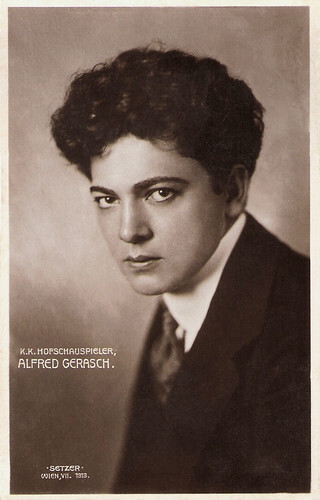
Austrian postcard by Postkartenverlag Brüder Kohn, Wien (Vienna). Photo: Setzer, Wien, 1913.
Alfred Gerasch (1877-1954) was a popular Austrian stage actor who belonged to the exclusive circle of the ‘Königlich-Kaiserlichen Hofschauspielern’ (Royal Court Actors). He also acted in several silent and sound films, often playing historical figures.
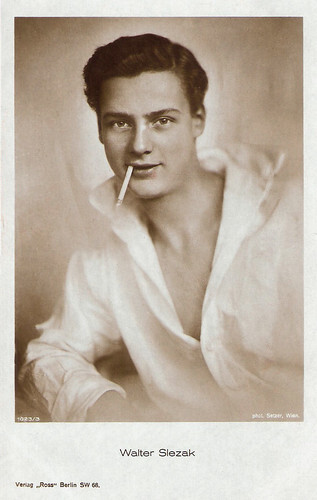
German postcard by Ross Verlag, Berlin, no. 1023/3, 1926-1927. Photo: Setzer, Wien (Vienna).
Austrian actor Walter Slezak (1902-1983) began his film career as a thin leading man in silent films. Unable to keep his weight under control, Slezak decided around 1930 to become a character actor. When the Nazis came into power he moved to Broadway and Hollywood, where he usually portrayed a villain or thug, but also played lighter, kindlier roles.
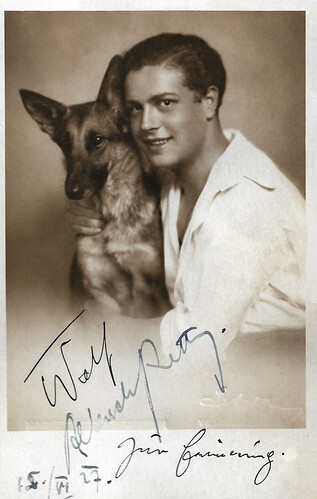
Austrian autograph card, signed in 1927. Photo: Franz Xaver Setzer, Wien.
The Austrian-German actor Wolf Albach-Retty (1906-1967) is nowadays best known as the father of Romy Schneider, but during the 1930s he was a popular leading man of German cinema.
A meeting place for the rich and beautiful, the bourgeoisie and artists
Franz Xaver Setzer was born Franz Anton Adolf in 1886 in Vienna. He received his training at the Imperial Royal Institute of Prints and Drawings. In 1909, he founded his own studio. The rooftop studio set up in 1911 in Museumstraße 5 in the seventh district soon became a meeting place for the rich and beautiful, the bourgeoisie and artists. The news that the portraits created in Setzer's well-lit studio were of the highest artistic quality had quickly spread in Vienna during the interwar years.
The ambience of "Setzer – Photographische Bildnisse, behind the German Volkstheater" – as an advertising card from early years describes the location – met the high demands and was equipped with "a lift and a telephone". Personalities from the theatre, opera and cultural scene of Setzer were portrayed in their early years. In recognition of the high quality of his work, Franz Xaver Setzer received the Voigtländer Medal of the Photographic Society in 1917.
Among the first customers before 1920 were the Royal Court actor Alfred Gerasch , composer Arnold Schönberg, the actress Hedwig Bleibtreu and the writer Stefan Zweig. He ran the studio with his future wife Friederike von Winternitz.
In 1920 Setzer married the opera singer Marie Gutheil-Schoder this marriage expanded his social position. In addition to contemporary artists, representatives of the aristocracy, politicians and economists were increasingly included in the group of people who were photographed by Setzer.
Alternating photos show that Franz Xaver Setzer also had friendly contacts with his contemporary colleagues, such as Madame d'Ora and Arthur Benda .
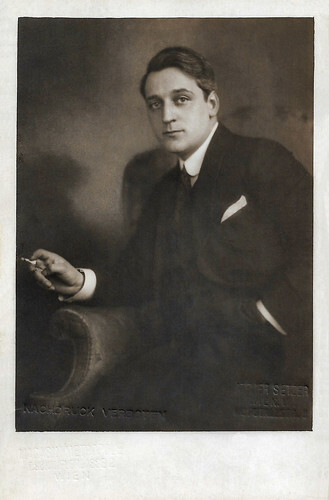
Austrian postcard by Magasin Metropole, Wien. Photo: Franz Xaver Setzer, Wien.
Raoul Aslan (1886-1958) was an Austrian theatre and film actor of Greek-Armenian ancestry. For many years he was a star at the Vienna Burgtheater. He was also the director of the famous from 1945 to 1948. Aslan was not particularly interested in films and only appeared in comparatively few productions.
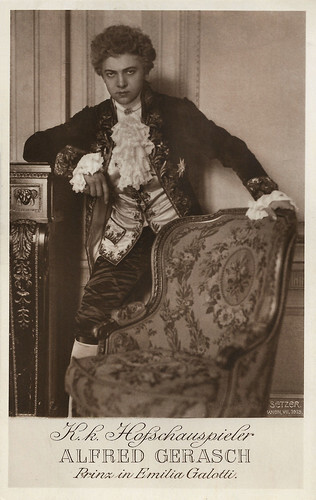
Austrian postcard by Postkartenverlag Brüder Kohn, Wien (Vienna), no. 887-1834. Photo: Setzer, Wien, 1913. Caption: K.K. Hofschauspieler Alfred Gerasch as the Prince in 'Emilia Galotti', a play in five acts by Gotthold Ephraim Lessing (1729–1781), which premiered on 8 March 1772 in Braunschweig (Brunswick).
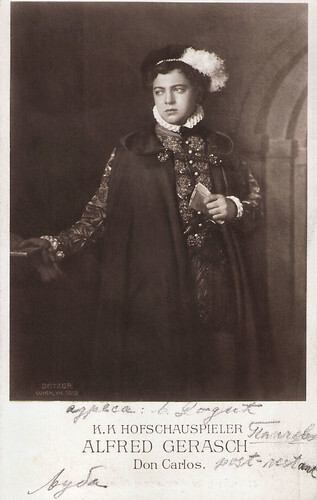
Austrian postcard. Photo by Setzer, Vienna, VII. 1913. Alfred Gerasch , 'K.u.K. Hofschauspieler (Royal and Imperial Court Actor) as Don Carlos in the homonymous play by Friedrich Schiller.
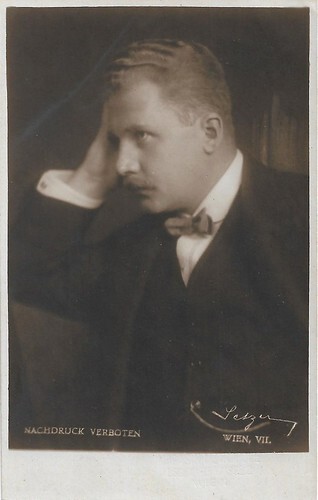
Austrian postcard. Photo: Franz Xaver Setzer, Vienna, VII.
Hans Marr (1878-1949) was a German actor and director. At the Burgtheater in Vienna, the handsome Marr was above all a hero actor and played especially in plays by Gerhart Hauptmann, with whom he was also a friend. From 1913 onwards, Marr was given film roles.
An invaluable gem of Viennese photographic history
Franz Xaver Setzer made repeated trips to Salzburg. The Salzburg Festival was an opportunity to make photos on location – for example, of Giacomo Puccini, Max Reinhardt and Maria Jeritza – as well as receiving commissions for the studio in Vienna.
In April 1920, twenty-year-old Marie Karoline Tschiedel took up a position as assistant to the artist in the studio. She had also studied at the KuK Graphische Lehr- und Versuchsanstalt and specialised in the fields of portrait photography and negative retouching.
The global economic crisis in the 1930s also affected the work in the studio. The situation deteriorated and Setzer withdrew, also for health reasons. Tschiedel, who had already worked closely with Setzer in recent years, became the technical director of the studio in 1934 and increasingly assumed overall responsibility for the studio.
At the age of 52, Franz Xaver Setzer died in January 1939 as a result of a serious illness. Marie Karoline Tschiedel took over the studio from his heirs and continued it under the name Setzer-Tschiedel. In 1945 part of the attic was badly damaged by a bomb hit.
Although the studio was not directly hit, work had to be stopped. After the end of the war, the studio was initially confiscated by the Russian occupying forces - but operations were soon resumed and continued until 1979. The studio has been preserved almost in its original condition to this day. The archive of the Setzer-Tschiedel photo studio is still family-owned today. It is an invaluable gem of Viennese photographic history and an extraordinary testimony to Viennese cultural history.
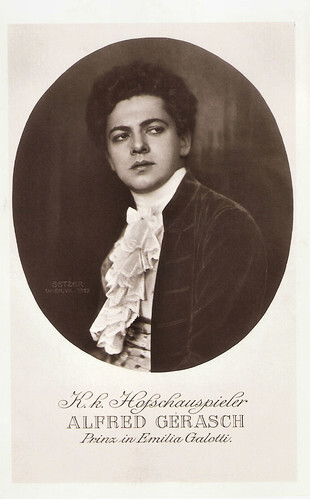
Austrian postcard by Postkartenverlag Brüder Kohn, Wien (Vienna). Photo: Setzer, Wien, 1913. Caption: Alfred Gerasch . Prinz in Emilia Galotti." (Prince in Emilia Galotti). Emilia Galotti is a play in five acts by Gotthold Ephraim Lessing (1729–1781), which premiered on 8 March 1772 in Brunswick ("Braunschweig" in German). The work is a classic example of German bürgerliches Trauerspiel (bourgeois tragedy). Lessing's work comprises an attack against the nobility and its powers. Lessing depicts aristocrats as having unfair powers in society and as ruining the happiness of the emerging middle class.
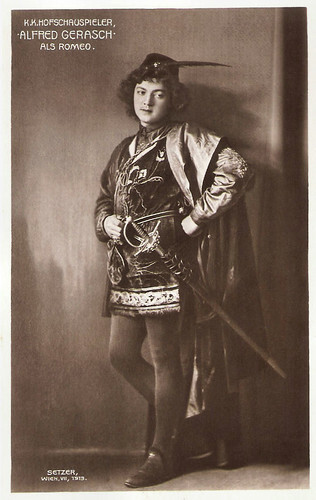
Austrian postcard by Postkartenverlag Brüder Kohn, Wien (Vienna). Photo: Setzer, Wien, 1913. Caption: " Alfred Gerasch als Romeo." (Alfred Gerasch as Romeo). Publicity still for a stage production of the play 'Romeo and Juliet' by William Shakespeare.
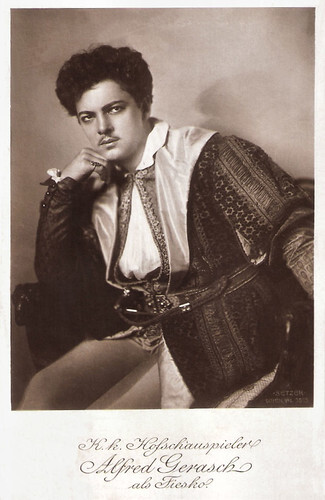
Austrian postcard by Postkartenverlag Brüder Kohn, Wien (Vienna), no. 887-1835. Photo: Setzer, Wien, 1913. Caption: K.k. Hofschauspieler Alfred Gerasch als Fiesko. Die Verschwörung des Fiesco zu Genua/Fiesco was the second full-length play by Friedrich Schiller. It is a republican tragedy based on the historical conspiracy of Giovanni Luigi Fieschi against Andrea Doria in Genoa in 1547. It premiered in Bonn in 1783 at the Hoftheater.
Sources: Wer Wien prägte (German), OTS (German), and Wikipedia (German and English).

Austrian postcard by Postkartenverlag Brüder Kohn, Wien (Vienna). Photo: Setzer, Wien, 1913.
Alfred Gerasch (1877-1954) was a popular Austrian stage actor who belonged to the exclusive circle of the ‘Königlich-Kaiserlichen Hofschauspielern’ (Royal Court Actors). He also acted in several silent and sound films, often playing historical figures.

German postcard by Ross Verlag, Berlin, no. 1023/3, 1926-1927. Photo: Setzer, Wien (Vienna).
Austrian actor Walter Slezak (1902-1983) began his film career as a thin leading man in silent films. Unable to keep his weight under control, Slezak decided around 1930 to become a character actor. When the Nazis came into power he moved to Broadway and Hollywood, where he usually portrayed a villain or thug, but also played lighter, kindlier roles.

Austrian autograph card, signed in 1927. Photo: Franz Xaver Setzer, Wien.
The Austrian-German actor Wolf Albach-Retty (1906-1967) is nowadays best known as the father of Romy Schneider, but during the 1930s he was a popular leading man of German cinema.
A meeting place for the rich and beautiful, the bourgeoisie and artists
Franz Xaver Setzer was born Franz Anton Adolf in 1886 in Vienna. He received his training at the Imperial Royal Institute of Prints and Drawings. In 1909, he founded his own studio. The rooftop studio set up in 1911 in Museumstraße 5 in the seventh district soon became a meeting place for the rich and beautiful, the bourgeoisie and artists. The news that the portraits created in Setzer's well-lit studio were of the highest artistic quality had quickly spread in Vienna during the interwar years.
The ambience of "Setzer – Photographische Bildnisse, behind the German Volkstheater" – as an advertising card from early years describes the location – met the high demands and was equipped with "a lift and a telephone". Personalities from the theatre, opera and cultural scene of Setzer were portrayed in their early years. In recognition of the high quality of his work, Franz Xaver Setzer received the Voigtländer Medal of the Photographic Society in 1917.
Among the first customers before 1920 were the Royal Court actor Alfred Gerasch , composer Arnold Schönberg, the actress Hedwig Bleibtreu and the writer Stefan Zweig. He ran the studio with his future wife Friederike von Winternitz.
In 1920 Setzer married the opera singer Marie Gutheil-Schoder this marriage expanded his social position. In addition to contemporary artists, representatives of the aristocracy, politicians and economists were increasingly included in the group of people who were photographed by Setzer.
Alternating photos show that Franz Xaver Setzer also had friendly contacts with his contemporary colleagues, such as Madame d'Ora and Arthur Benda .

Austrian postcard by Magasin Metropole, Wien. Photo: Franz Xaver Setzer, Wien.
Raoul Aslan (1886-1958) was an Austrian theatre and film actor of Greek-Armenian ancestry. For many years he was a star at the Vienna Burgtheater. He was also the director of the famous from 1945 to 1948. Aslan was not particularly interested in films and only appeared in comparatively few productions.

Austrian postcard by Postkartenverlag Brüder Kohn, Wien (Vienna), no. 887-1834. Photo: Setzer, Wien, 1913. Caption: K.K. Hofschauspieler Alfred Gerasch as the Prince in 'Emilia Galotti', a play in five acts by Gotthold Ephraim Lessing (1729–1781), which premiered on 8 March 1772 in Braunschweig (Brunswick).

Austrian postcard. Photo by Setzer, Vienna, VII. 1913. Alfred Gerasch , 'K.u.K. Hofschauspieler (Royal and Imperial Court Actor) as Don Carlos in the homonymous play by Friedrich Schiller.

Austrian postcard. Photo: Franz Xaver Setzer, Vienna, VII.
Hans Marr (1878-1949) was a German actor and director. At the Burgtheater in Vienna, the handsome Marr was above all a hero actor and played especially in plays by Gerhart Hauptmann, with whom he was also a friend. From 1913 onwards, Marr was given film roles.
An invaluable gem of Viennese photographic history
Franz Xaver Setzer made repeated trips to Salzburg. The Salzburg Festival was an opportunity to make photos on location – for example, of Giacomo Puccini, Max Reinhardt and Maria Jeritza – as well as receiving commissions for the studio in Vienna.
In April 1920, twenty-year-old Marie Karoline Tschiedel took up a position as assistant to the artist in the studio. She had also studied at the KuK Graphische Lehr- und Versuchsanstalt and specialised in the fields of portrait photography and negative retouching.
The global economic crisis in the 1930s also affected the work in the studio. The situation deteriorated and Setzer withdrew, also for health reasons. Tschiedel, who had already worked closely with Setzer in recent years, became the technical director of the studio in 1934 and increasingly assumed overall responsibility for the studio.
At the age of 52, Franz Xaver Setzer died in January 1939 as a result of a serious illness. Marie Karoline Tschiedel took over the studio from his heirs and continued it under the name Setzer-Tschiedel. In 1945 part of the attic was badly damaged by a bomb hit.
Although the studio was not directly hit, work had to be stopped. After the end of the war, the studio was initially confiscated by the Russian occupying forces - but operations were soon resumed and continued until 1979. The studio has been preserved almost in its original condition to this day. The archive of the Setzer-Tschiedel photo studio is still family-owned today. It is an invaluable gem of Viennese photographic history and an extraordinary testimony to Viennese cultural history.

Austrian postcard by Postkartenverlag Brüder Kohn, Wien (Vienna). Photo: Setzer, Wien, 1913. Caption: Alfred Gerasch . Prinz in Emilia Galotti." (Prince in Emilia Galotti). Emilia Galotti is a play in five acts by Gotthold Ephraim Lessing (1729–1781), which premiered on 8 March 1772 in Brunswick ("Braunschweig" in German). The work is a classic example of German bürgerliches Trauerspiel (bourgeois tragedy). Lessing's work comprises an attack against the nobility and its powers. Lessing depicts aristocrats as having unfair powers in society and as ruining the happiness of the emerging middle class.

Austrian postcard by Postkartenverlag Brüder Kohn, Wien (Vienna). Photo: Setzer, Wien, 1913. Caption: " Alfred Gerasch als Romeo." (Alfred Gerasch as Romeo). Publicity still for a stage production of the play 'Romeo and Juliet' by William Shakespeare.

Austrian postcard by Postkartenverlag Brüder Kohn, Wien (Vienna), no. 887-1835. Photo: Setzer, Wien, 1913. Caption: K.k. Hofschauspieler Alfred Gerasch als Fiesko. Die Verschwörung des Fiesco zu Genua/Fiesco was the second full-length play by Friedrich Schiller. It is a republican tragedy based on the historical conspiracy of Giovanni Luigi Fieschi against Andrea Doria in Genoa in 1547. It premiered in Bonn in 1783 at the Hoftheater.
Sources: Wer Wien prägte (German), OTS (German), and Wikipedia (German and English).
Published on December 15, 2023 22:00
December 14, 2023
Shirley Anne Field (1938-2023)
British actress Shirley Anne Field (1936-2023) passed away on 10 December 2023. The former Miss London has performed on stage, film and television since 1955. She starred in such classic films as The Entertainer (1960), Saturday Night and Sunday Morning (1960), Alfie (1966), and My Beautiful Laundrette (1985). Field was 87.
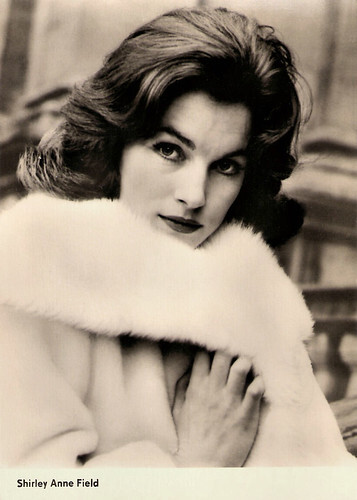
East-German postcard by VEB Progress Film-Vertrieb, Berlin, no. 1623, 1961. Retail price: 0,20 MDN. Photo: Progress.
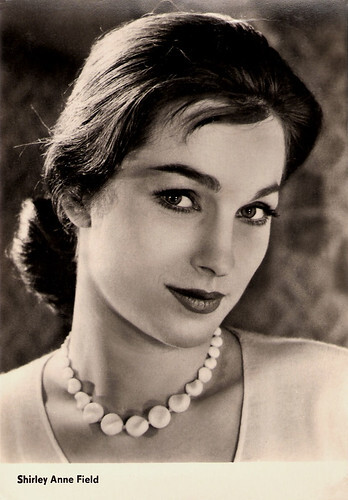
East-German postcard by VEB Progress Film-Vertrieb, Berlin.
Masterpiece
Shirley Anne Field was born Shirley Broomfield in Bolton, Great Britain, in 1938. She and her brother were brought up in the Edgworth Children's Home and Orphanage because their mother could not care for them. Many years later, her brother, publisher Guy Broomfield, would become a murder victim in the United States.
Field started as a Beauty Queen and was chosen Miss London. She modelled in glamour photographs for magazines, including Reveille and Titbits. Her first appearance in a film was as an extra in the soap opera satire Simon and Laura (Muriel Box, 1955). According to Brian McFarlane of the Encyclopaedia of British Film , she appeared “without making much impression beyond that of exceptionally pretty ingénue.”
The following years followed bigger parts in The Flesh Is Weak (Don Chaffey, 1957) starring John Derek, and the comedy Upstairs and Downstairs (Ralph Thomas, 1959). Field appeared as a murder victim in the violent Horrors of the Black Museum (Arthur Crabtree, 1959) with Michael Gough.
Shirley Anne Field played a temperamental film star in the equally violent Peeping Tom (Michael Powell, 1960) with Karlheinz Böhm (as Carl Boehm). The British critics hated the film at the time, but Peeping Tom is now seen as a classic. The Sunday Times' Dilys Powell, who in 1960 thought it "essentially vicious", admitted in 1994: "Today, I find I am convinced it is a masterpiece". Then Field was chosen by Laurence Olivier to play the prime female role in The Entertainer (Tony Richardson, 1960), which made her name.
Next, the actress appeared as Albert Finney ’s pregnant girlfriend in another British New Wave entry, Saturday Night - Sunday Morning (Karel Reisz, 1960). Phil Wickham at BFI Screenonline comments: “Saturday Night and Sunday Morning (1960) is the 'new wave' film which has most preserved its reputation with modern critics. Added to the critical support at the time and its massive - and unexpected - box office success, it has some claim to be the most significant of the films of this period.” 1960 must have been a top year for Field. She also appeared in the films Man in the Moon (Basil Dearden, 1960), Beat Girl (Edmond T. Gréville, 1960) and Once More, with Feeling! (Stanley Donen, 1960) starring Yul Brynner .
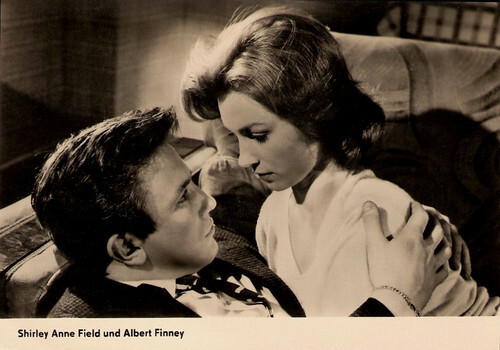
East-German postcard by VEB Progress Film-Vertrieb, Berlin, no. 1615, 1961. Retail price: 0,20 DM. Photo: Progress. Publicity still for Saturday Night and Sunday Morning (Karel Reisz, 1960).
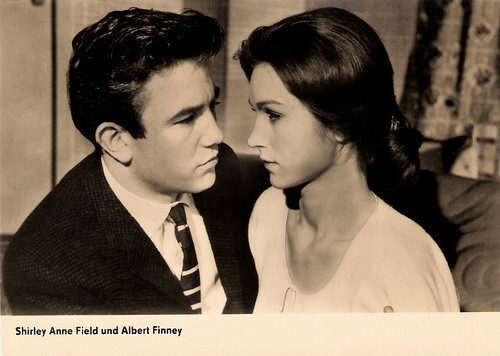
East-German postcard by VEB Progress Film-Vertrieb, Berlin, no. 1614, 1961. Retail price: 0,20 DM. Photo: Progress. Publicity still for Saturday Night and Sunday Morning (Karel Reisz, 1960).
Surprise box-office hit
Shirley Anne Field kept busy filming in the first half of the sixties. She played in The War Lover (Philip Leacock, 1962) starring Steve McQueen , and she was the sister of Oliver Reed in the Sci-Fi film The Damned (Joseph Losey, 1963). A trip to Hollywood for Kings of the Sun (J. Lee Thompson, 1963) with Yul Brynner , proved disappointing. In Italy, she appeared opposite Vittorio Gassman in Marcia nuziale/Wedding March (Marco Ferreri, 1965).
Field continued appearing in British films including the Doctor comedy Doctor in Clover (Ralph Thomas, 1966) and the hit Alfie (Lewis Gilbert, 1966) as one of the girlfriends of Michael Caine . In 1967 she married former racing driver and executive jet pilot Charlie Crichton-Stuart. From then on, she would appear incidentally in films such as the South African production House of the Living Dead/Curse of the Dead (Ray Austin, 1970) with Mark Burns.
During the 1970s, Shirley Anne Field spent some time on the stage, including an acclaimed performance in the South African production of 'Wait Until Dark'. She was out of films for a decade. In 1985 she returned to the cinema in the surprise box-office hit My Beautiful Laundrette (Stephen Frears, 1985) about a gay Pakistani/National Front romance. She played Rachel, Saeed Jaffrey's warm-hearted mistress.
She then also appeared in such films as the Hollywood production Shag (Zelda Barron, 1989), the British comedy Getting It Right (Randal Kleiser, 1989) and the romantic comedy Hear My Song (Peter Chelsom, 1991) starring Adrian Dunbar. On television, she was featured in Ken Russell’s Lady Chatterley (1993). Among her many TV appearances are also parts in such American and British series as Shoestring (1979), Santa Barbara (1987), Murder She Wrote (1992), Dalziel and Pascoe (1999), The Bill (2000), Waking the Dead (2003), Monarch of the Glen (2005), and Last of the Summer Wine (2008).
Shirley Anne Field continued to perform on stage, such as shady lady Lottie Grady in 'When We Are Married' (1996). Later she appeared in such films as the drama The Kid (Nick Moran, 2010) and the comedy The Power of Three (Yvonne Deutschman, 2011) with Toyah Wilcox. Field wrote an autobiography A Time for Love (1991). She had one daughter, Nicola Jane Crichton-Stuart (1967).
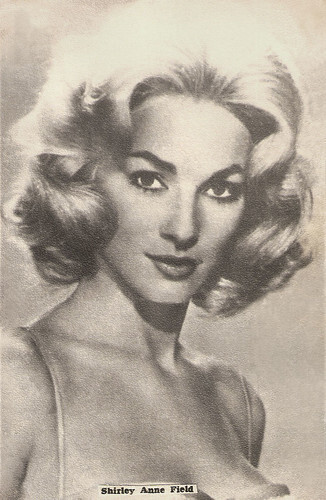
Vintage card.
Trailer of My Beautiful Laundrette (1985). Source: ryy79 (YouTube).
Sources: Brian McFarlane (Encyclopedia of British Film), Phil Wickham (BFI Screenonline), (IMDb), Hal Erickson (AllMovie), Wikipedia, and .

East-German postcard by VEB Progress Film-Vertrieb, Berlin, no. 1623, 1961. Retail price: 0,20 MDN. Photo: Progress.

East-German postcard by VEB Progress Film-Vertrieb, Berlin.
Masterpiece
Shirley Anne Field was born Shirley Broomfield in Bolton, Great Britain, in 1938. She and her brother were brought up in the Edgworth Children's Home and Orphanage because their mother could not care for them. Many years later, her brother, publisher Guy Broomfield, would become a murder victim in the United States.
Field started as a Beauty Queen and was chosen Miss London. She modelled in glamour photographs for magazines, including Reveille and Titbits. Her first appearance in a film was as an extra in the soap opera satire Simon and Laura (Muriel Box, 1955). According to Brian McFarlane of the Encyclopaedia of British Film , she appeared “without making much impression beyond that of exceptionally pretty ingénue.”
The following years followed bigger parts in The Flesh Is Weak (Don Chaffey, 1957) starring John Derek, and the comedy Upstairs and Downstairs (Ralph Thomas, 1959). Field appeared as a murder victim in the violent Horrors of the Black Museum (Arthur Crabtree, 1959) with Michael Gough.
Shirley Anne Field played a temperamental film star in the equally violent Peeping Tom (Michael Powell, 1960) with Karlheinz Böhm (as Carl Boehm). The British critics hated the film at the time, but Peeping Tom is now seen as a classic. The Sunday Times' Dilys Powell, who in 1960 thought it "essentially vicious", admitted in 1994: "Today, I find I am convinced it is a masterpiece". Then Field was chosen by Laurence Olivier to play the prime female role in The Entertainer (Tony Richardson, 1960), which made her name.
Next, the actress appeared as Albert Finney ’s pregnant girlfriend in another British New Wave entry, Saturday Night - Sunday Morning (Karel Reisz, 1960). Phil Wickham at BFI Screenonline comments: “Saturday Night and Sunday Morning (1960) is the 'new wave' film which has most preserved its reputation with modern critics. Added to the critical support at the time and its massive - and unexpected - box office success, it has some claim to be the most significant of the films of this period.” 1960 must have been a top year for Field. She also appeared in the films Man in the Moon (Basil Dearden, 1960), Beat Girl (Edmond T. Gréville, 1960) and Once More, with Feeling! (Stanley Donen, 1960) starring Yul Brynner .

East-German postcard by VEB Progress Film-Vertrieb, Berlin, no. 1615, 1961. Retail price: 0,20 DM. Photo: Progress. Publicity still for Saturday Night and Sunday Morning (Karel Reisz, 1960).

East-German postcard by VEB Progress Film-Vertrieb, Berlin, no. 1614, 1961. Retail price: 0,20 DM. Photo: Progress. Publicity still for Saturday Night and Sunday Morning (Karel Reisz, 1960).
Surprise box-office hit
Shirley Anne Field kept busy filming in the first half of the sixties. She played in The War Lover (Philip Leacock, 1962) starring Steve McQueen , and she was the sister of Oliver Reed in the Sci-Fi film The Damned (Joseph Losey, 1963). A trip to Hollywood for Kings of the Sun (J. Lee Thompson, 1963) with Yul Brynner , proved disappointing. In Italy, she appeared opposite Vittorio Gassman in Marcia nuziale/Wedding March (Marco Ferreri, 1965).
Field continued appearing in British films including the Doctor comedy Doctor in Clover (Ralph Thomas, 1966) and the hit Alfie (Lewis Gilbert, 1966) as one of the girlfriends of Michael Caine . In 1967 she married former racing driver and executive jet pilot Charlie Crichton-Stuart. From then on, she would appear incidentally in films such as the South African production House of the Living Dead/Curse of the Dead (Ray Austin, 1970) with Mark Burns.
During the 1970s, Shirley Anne Field spent some time on the stage, including an acclaimed performance in the South African production of 'Wait Until Dark'. She was out of films for a decade. In 1985 she returned to the cinema in the surprise box-office hit My Beautiful Laundrette (Stephen Frears, 1985) about a gay Pakistani/National Front romance. She played Rachel, Saeed Jaffrey's warm-hearted mistress.
She then also appeared in such films as the Hollywood production Shag (Zelda Barron, 1989), the British comedy Getting It Right (Randal Kleiser, 1989) and the romantic comedy Hear My Song (Peter Chelsom, 1991) starring Adrian Dunbar. On television, she was featured in Ken Russell’s Lady Chatterley (1993). Among her many TV appearances are also parts in such American and British series as Shoestring (1979), Santa Barbara (1987), Murder She Wrote (1992), Dalziel and Pascoe (1999), The Bill (2000), Waking the Dead (2003), Monarch of the Glen (2005), and Last of the Summer Wine (2008).
Shirley Anne Field continued to perform on stage, such as shady lady Lottie Grady in 'When We Are Married' (1996). Later she appeared in such films as the drama The Kid (Nick Moran, 2010) and the comedy The Power of Three (Yvonne Deutschman, 2011) with Toyah Wilcox. Field wrote an autobiography A Time for Love (1991). She had one daughter, Nicola Jane Crichton-Stuart (1967).

Vintage card.
Trailer of My Beautiful Laundrette (1985). Source: ryy79 (YouTube).
Sources: Brian McFarlane (Encyclopedia of British Film), Phil Wickham (BFI Screenonline), (IMDb), Hal Erickson (AllMovie), Wikipedia, and .
Published on December 14, 2023 22:00
December 13, 2023
Audrey Tautou
Audrey Tautou (1976) is a French actress known for her gamine beauty and elfin charm. She received critical acclaim for her feature film debut in Vénus beauté (institut)/Venus Beauty Institute (1999), and won the César Award for Most Promising Actress. She made her international breakthrough with her starring role as Amélie in the cinema hit Le fabuleux destin d'Amélie Poulain/Amélie (2001). For that, she was nominated for a César and a BAFTA Award. Playing mainly in French films, Tautou also appeared in the British thriller Dirty Pretty Things (2002) and the American blockbuster The Da Vinci Code (2006).
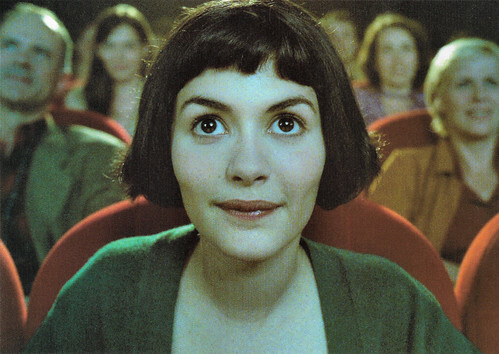
British postcard by Odeon. Photo: Momentum Pictures. Audrey Tautou in Le Fabuleux Destin d'Amélie Poulain (Jean-Pierre Jeunet, 2001).
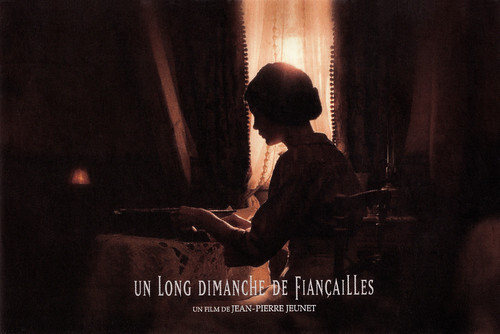
French postcard by Warner Bros, France / Tapioca Films / TF1 Films Production. Audrey Tautou on the English poster for Un long dimanche de fiançailles/A Very Long Engagement (Jean-Pierre Jeunet, 2004).
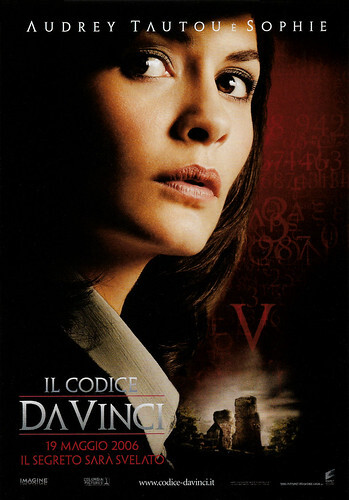
Italian promocard by The Cult Advertising, no. PC 6390. Image: Imagine / Columbia Pictures / Sony Pictures. Audrey Tautou in The Da Vinci Code (Ron Howard, 2006). Caption: Audrey Tautou is Sophie. 19 May 2006, the secret will be revealed.
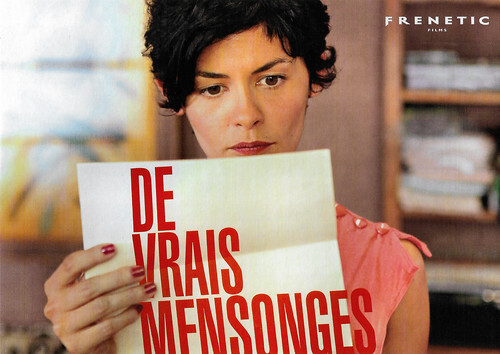
Swiss postcard by Frenetic. Photo: Frenetic Films. Audrey Tautou in De vrais mensonges/Beautiful Lies (Pierre Salvadori, 2010).
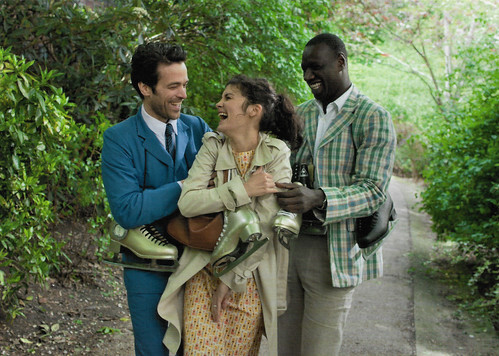
Swiss postcard by Frenetic.ch. Photo: Romain Duris, Audrey Tautou and Omar Sy in L'écume des jours/Mood Indigo (Michel Gondry, 2013).
Amélie
Audrey Justine Tautou was born in Beaumont, France in 1976. She was the daughter of a dental surgeon, Bernard Tautou, and a teacher, Évelyne Tautou, also a former deputy mayor of Montluçon. She spent her childhood and teenage years in Montluçon with her two sisters and brother. Audrey, reportedly named after Audrey Hepburn, discovered early in life that playing comedy suited her and she trained at Cours Florent in Paris.
She began her acting career with several television movies in the late 1990s and received the award for best young actress at the Jeune Comedien de Cinema Festival in Béziers in 1998. Tautou won a talent search contest sponsored by Canal+, a French media company in 1999.
Thanks in part to her striking appearance and girlish looks, she caught the eye of director Tonie Marshall, who gave the 22-years-old actress the role of a naive salon worker in her film Vénus Beauté (institut)/Venus Beauty Institute (Tonie Marshall, 1999). For this film, she received the Prix Suzanne Bianchetti as her country's most promising young film actress. In 2000 she was a fixture in French cinemas, appearing in Épouse-moi/Marry Me (Harriet Marin, 2000), Voyous voyelle/Pretty Devils (Serge Meynard, 2000), Le Libertin/The Libertine (Gabriel Aghion, 2000) with Vincent Pérez , and Le Battement d’ailes du papillon/Happenstance (Laurent Firtode, 2000).
The following year, she made her international breakthrough with her starring role in Le fabuleux destin d'Amélie Poulain/Amélie (Jean-Pierre Jeunet, 2001). In this romantic fable, she starred as a shy and lonely waitress who concocts elaborate schemes to make others happy and in the process falls in love. Grossing over $33 million in limited theatrical release, the film became the top-grossing French-language movie of all time in the United States and scored five Oscar nominations, including one for best foreign-language film. It also earned Tautou a BAFTA (British Academy of Film and Television Arts) nomination for best actress and a César nomination.
In 2002 she appeared opposite Romain Duris in the ensemble comedy L’Auberge espagnole/The Spanish Apartment (Cédric Klapisch, 2002) about foreign exchange students. There were two sequels, Les Poupées russes/Russian Dolls (Cédric Klapisch, 2005) and Casse-tête chinois/Chinese Puzzle (Cédric Klapisch, 2013), which followed the characters as they aged.
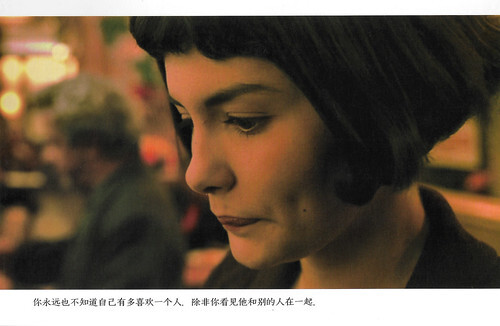
Chinese postcard. Photo: Momentum Pictures. Audrey Tautou in Le Fabuleux Destin d'Amélie Poulain (Jean-Pierre Jeunet, 2001).
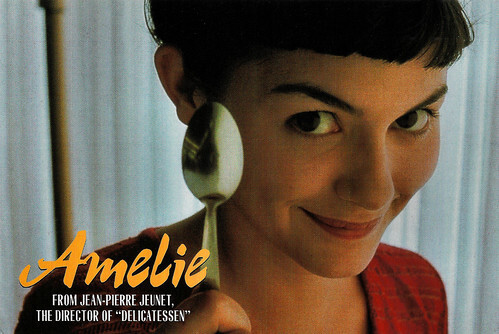
Australian postcard by AvantCard, no. 6148, Postcard 2 in a series of 6. Photo: Dendy. Audrey Tatou in Le fabuleux destin d'Amélie Poulain/Amelie (Jean-Pierre Jeunet, 2001). Caption: Amelie lives in Paris and in a world of her own. She cultivates a taste for small pleasures. Like skimming stones on St. Martin's Canal. And cracking crème brulée with a teaspoon.
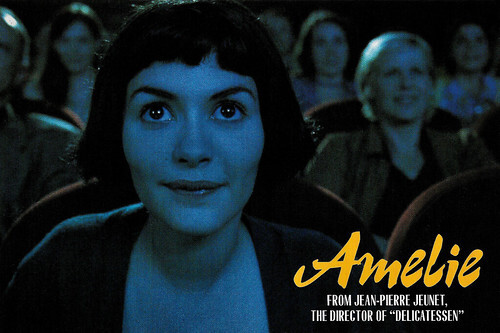
Australian postcard by AvantCard, no. 6149, Postcard 3 in a series of 6. Photo: Dendy. Audrey Tatou in Le fabuleux destin d'Amélie Poulain/Amelie (Jean-Pierre Jeunet, 2001). Caption: Amelie lives in Paris and in a world of her own. Some Fridays, Amelie goes to the movies. She likes looking back at people's faces in the dark. Amelie notices the shy people always laugh the loudest.
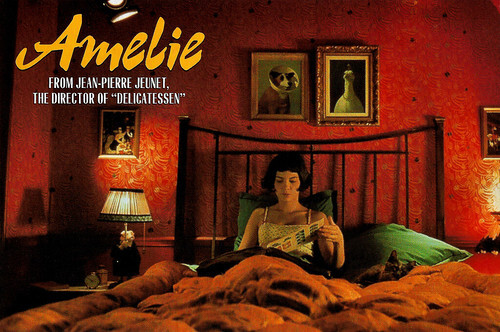
Australian postcard by AvantCard, no. 6150, Postcard 4 in a series of 6. Photo: Dendy. Audrey Tatou in Le fabuleux destin d'Amélie Poulain/Amelie (Jean-Pierre Jeunet, 2001). Caption: Amelie lives in Paris and in a world of her own. She tries hard to fix other people's messy lives. But what about her own life? Who'll fix that?
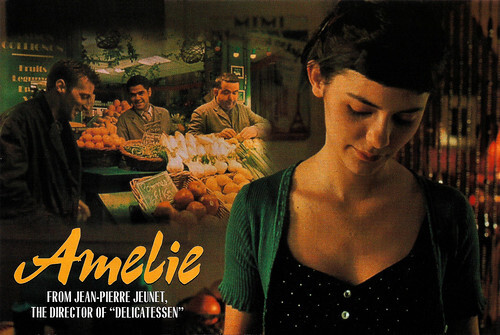
Australian postcard by AvantCard, no. 6152, Postcard 6 in a series of 6. Photo: Dendy. Audrey Tatou, Mathieu Kassovitz, Jamel Debbouze and Urbain Cancelier in Le fabuleux destin d'Amélie Poulain/Amelie (Jean-Pierre Jeunet, 2001). Caption: Amelie lives in Paris and in a world of her own. But maybe her thoughts are with someone else. Someone she's known since always. Could Amelie be falling in love?
Coco Chanel
Audrey Tautou mainly acts in French films, including the musical Pas sur la bouche/Not on the Lips (Alain Resnais, 2003). Tautou reteamed with Jeunet for the César award-winning drama Un Long Dimanche de fiançailles/A Very Long Engagement (Jean-Pierre Jeunet, 2004). In this ambitious international adaptation of Sébastien Japrisot's novel of the same name, she played a woman searching for her lost fiancé after World War I.
She made her English language debut in the British thriller Dirty Pretty Things (Stephen Frears, 2002) and later appeared in Nowhere to Go but Up (Amos Kollek, 2003). She also played agent Sophie Neveu alongside Tom Hanks in the American blockbuster The Da Vinci Code (Ron Howard, 2006), an adaptation of Dan Brown's novel. In both, she speaks English.
Soon thereafter she returned to the more intimate French films that made her famous. Subsequent movies included the well-received romantic comedies Hors de prix/Priceless (Pierre Salvadori, 2006) and Ensemble, c’est tout/Hunting and Gathering (Claude Berri, 2007). In 2009 she portrayed French fashion designer Coco Chanel in the biopic Coco avant Chanel/Coco Before Chanel (Anne Fontaine, 2009). That year, Tautou was also Nicole Kidman 's successor as the face of Chanel No. 5 perfume in a short film directed by Jean-Pierre Jeunet and a photo campaign by Dominique Issermann. In 2012, Tautou was in turn succeeded by American actor Brad Pitt .
In 2010, she took to the stage to star in her first play, 'Une maison de poupée' (A Doll's House), written by Henrik Ibsen. Directed by Michel Fau, it was performed at the Théâtre de la Madeleine. In the cinema, she evinced a widow who is drawn out of mourning by an oafish coworker in La Délicatesse/Delicacy (Stéphane and David Foenkinos, 2011) and played the murderous title heroine in Thérèse Desqueyroux/Thérèse (Claude Miller, 2012), an adaptation of the François Mauriac novel. Tautou’s character, a woman with a water lily growing in her lung, was the locus of Michel Gondry’s absurdist fantasy L’Écume des jours/Mood Indigo (Michel Gondry, 2013). She also played the mother of a talented young artist in Gondry’s Microbe et gasoil/Microbe & Gasoline (Michel Gondry, 2015) and voiced a journalist in the animated fantasy Phantom Boy (Jean-Loup Felicioli, Alain Gagnol, 2015).
Since 2015, she has kept a low profile. However, she incidentally appeared in films such as L’Odyssée/The Odyssey (Jérôme Salle, 2016), a biopic about Jacques Cousteau, the family comedy Santa & Cie/Christmas & Co. (Alain Chabat, 2017) and En liberte!/The Trouble with You (Pierre Salvadori, 2018), in which she played the wife of a man wrongfully imprisoned. She also played a free-spirited hairdresser in the crime comedy The Jesus Rolls (John Turturro, 2019), a remake of Les valseuses/Going Places (Bertrand Blier, 1974). She was one of the few French actresses to join the Academy of Motion Picture Arts and Sciences (AMPAS) in June 2004. Audrey Tautou has modelled for the likes of Montblanc and L'Oréal. Until December 2008, Audrey Tautou was the partner of rock and pop singer-songwriter Matthieu Chedid, known by the pseudonym M. In 2019, she adopted a Vietnamese baby girl.
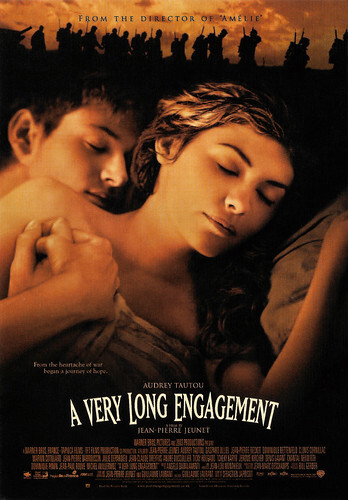
French postcard by Sonis, noo. C. 1586. Image: Warner Brothers. Gaspard Ulliel and Audrey Tautou on the English poster for Un long dimanche de fiançailles/A Very Long Engagement (Jean-Pierre Jeunet, 2004).
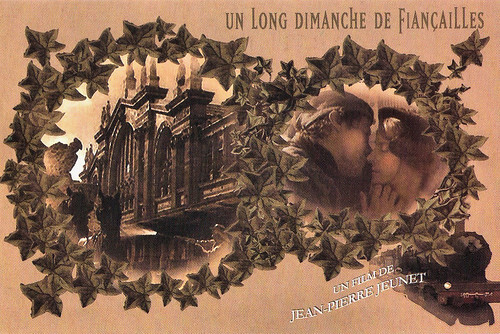
French postcard by Warner Bros, France / Tapioca Films / TF1 Films Production. Gaspard Ulliel and Audrey Tautou on the English poster for Un long dimanche de fiançailles/A Very Long Engagement (Jean-Pierre Jeunet, 2004).
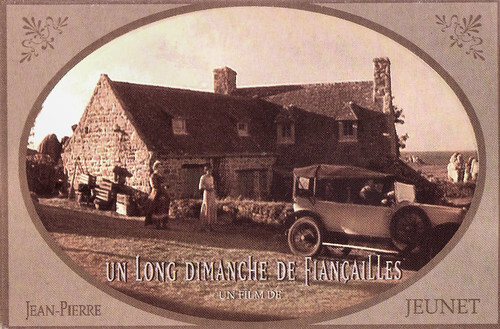
French postcard by Warner Bros, France / Tapioca Films / TF1 Films Production. Scene from Un long dimanche de fiançailles/A Very Long Engagement (Jean-Pierre Jeunet, 2004).
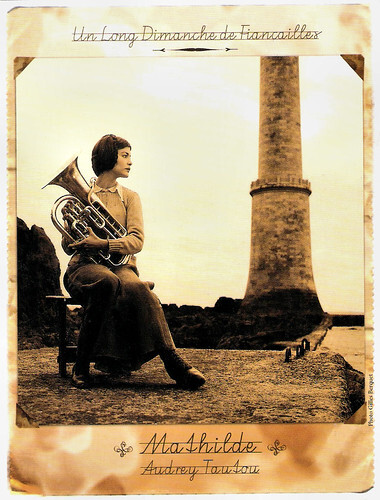
French postcard by Warner Bros, France / Tapioca Films / TF1 Films Production. Poster by Laurent Lufroy. Photo: Bruno Calvo. Publicity still for Un long dimanche de fiançailles/A Very Long Engagement (Jean-Pierre Jeunet, 2004).
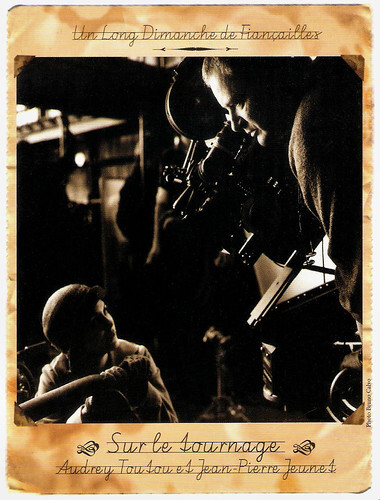
French postcard by Warner Bros, France / Tapioca Films / TF1 Films Production. Poster by Laurent Lufroy. Photo: Bruno Calvo. Audrey Tautou and Jean-Pierre Jeunet during the shooting of Un long dimanche de fiançailles/A Very Long Engagement (Jean-Pierre Jeunet, 2004).
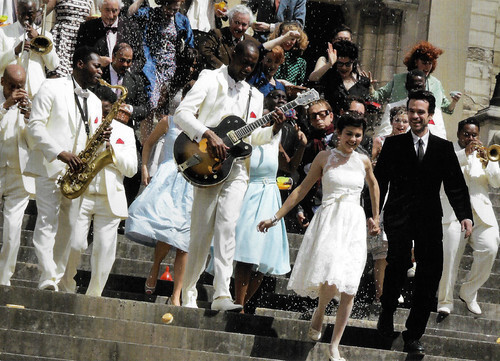
Swiss postcard by Frenetic.ch. Photo: Audrey Tautou and Romain Duris in L'écume des jours/Mood Indigo (Michel Gondry, 2013).
Sources: Britannica, Wikipedia (Dutch, French and English) and .

British postcard by Odeon. Photo: Momentum Pictures. Audrey Tautou in Le Fabuleux Destin d'Amélie Poulain (Jean-Pierre Jeunet, 2001).

French postcard by Warner Bros, France / Tapioca Films / TF1 Films Production. Audrey Tautou on the English poster for Un long dimanche de fiançailles/A Very Long Engagement (Jean-Pierre Jeunet, 2004).

Italian promocard by The Cult Advertising, no. PC 6390. Image: Imagine / Columbia Pictures / Sony Pictures. Audrey Tautou in The Da Vinci Code (Ron Howard, 2006). Caption: Audrey Tautou is Sophie. 19 May 2006, the secret will be revealed.

Swiss postcard by Frenetic. Photo: Frenetic Films. Audrey Tautou in De vrais mensonges/Beautiful Lies (Pierre Salvadori, 2010).

Swiss postcard by Frenetic.ch. Photo: Romain Duris, Audrey Tautou and Omar Sy in L'écume des jours/Mood Indigo (Michel Gondry, 2013).
Amélie
Audrey Justine Tautou was born in Beaumont, France in 1976. She was the daughter of a dental surgeon, Bernard Tautou, and a teacher, Évelyne Tautou, also a former deputy mayor of Montluçon. She spent her childhood and teenage years in Montluçon with her two sisters and brother. Audrey, reportedly named after Audrey Hepburn, discovered early in life that playing comedy suited her and she trained at Cours Florent in Paris.
She began her acting career with several television movies in the late 1990s and received the award for best young actress at the Jeune Comedien de Cinema Festival in Béziers in 1998. Tautou won a talent search contest sponsored by Canal+, a French media company in 1999.
Thanks in part to her striking appearance and girlish looks, she caught the eye of director Tonie Marshall, who gave the 22-years-old actress the role of a naive salon worker in her film Vénus Beauté (institut)/Venus Beauty Institute (Tonie Marshall, 1999). For this film, she received the Prix Suzanne Bianchetti as her country's most promising young film actress. In 2000 she was a fixture in French cinemas, appearing in Épouse-moi/Marry Me (Harriet Marin, 2000), Voyous voyelle/Pretty Devils (Serge Meynard, 2000), Le Libertin/The Libertine (Gabriel Aghion, 2000) with Vincent Pérez , and Le Battement d’ailes du papillon/Happenstance (Laurent Firtode, 2000).
The following year, she made her international breakthrough with her starring role in Le fabuleux destin d'Amélie Poulain/Amélie (Jean-Pierre Jeunet, 2001). In this romantic fable, she starred as a shy and lonely waitress who concocts elaborate schemes to make others happy and in the process falls in love. Grossing over $33 million in limited theatrical release, the film became the top-grossing French-language movie of all time in the United States and scored five Oscar nominations, including one for best foreign-language film. It also earned Tautou a BAFTA (British Academy of Film and Television Arts) nomination for best actress and a César nomination.
In 2002 she appeared opposite Romain Duris in the ensemble comedy L’Auberge espagnole/The Spanish Apartment (Cédric Klapisch, 2002) about foreign exchange students. There were two sequels, Les Poupées russes/Russian Dolls (Cédric Klapisch, 2005) and Casse-tête chinois/Chinese Puzzle (Cédric Klapisch, 2013), which followed the characters as they aged.

Chinese postcard. Photo: Momentum Pictures. Audrey Tautou in Le Fabuleux Destin d'Amélie Poulain (Jean-Pierre Jeunet, 2001).

Australian postcard by AvantCard, no. 6148, Postcard 2 in a series of 6. Photo: Dendy. Audrey Tatou in Le fabuleux destin d'Amélie Poulain/Amelie (Jean-Pierre Jeunet, 2001). Caption: Amelie lives in Paris and in a world of her own. She cultivates a taste for small pleasures. Like skimming stones on St. Martin's Canal. And cracking crème brulée with a teaspoon.

Australian postcard by AvantCard, no. 6149, Postcard 3 in a series of 6. Photo: Dendy. Audrey Tatou in Le fabuleux destin d'Amélie Poulain/Amelie (Jean-Pierre Jeunet, 2001). Caption: Amelie lives in Paris and in a world of her own. Some Fridays, Amelie goes to the movies. She likes looking back at people's faces in the dark. Amelie notices the shy people always laugh the loudest.

Australian postcard by AvantCard, no. 6150, Postcard 4 in a series of 6. Photo: Dendy. Audrey Tatou in Le fabuleux destin d'Amélie Poulain/Amelie (Jean-Pierre Jeunet, 2001). Caption: Amelie lives in Paris and in a world of her own. She tries hard to fix other people's messy lives. But what about her own life? Who'll fix that?

Australian postcard by AvantCard, no. 6152, Postcard 6 in a series of 6. Photo: Dendy. Audrey Tatou, Mathieu Kassovitz, Jamel Debbouze and Urbain Cancelier in Le fabuleux destin d'Amélie Poulain/Amelie (Jean-Pierre Jeunet, 2001). Caption: Amelie lives in Paris and in a world of her own. But maybe her thoughts are with someone else. Someone she's known since always. Could Amelie be falling in love?
Coco Chanel
Audrey Tautou mainly acts in French films, including the musical Pas sur la bouche/Not on the Lips (Alain Resnais, 2003). Tautou reteamed with Jeunet for the César award-winning drama Un Long Dimanche de fiançailles/A Very Long Engagement (Jean-Pierre Jeunet, 2004). In this ambitious international adaptation of Sébastien Japrisot's novel of the same name, she played a woman searching for her lost fiancé after World War I.
She made her English language debut in the British thriller Dirty Pretty Things (Stephen Frears, 2002) and later appeared in Nowhere to Go but Up (Amos Kollek, 2003). She also played agent Sophie Neveu alongside Tom Hanks in the American blockbuster The Da Vinci Code (Ron Howard, 2006), an adaptation of Dan Brown's novel. In both, she speaks English.
Soon thereafter she returned to the more intimate French films that made her famous. Subsequent movies included the well-received romantic comedies Hors de prix/Priceless (Pierre Salvadori, 2006) and Ensemble, c’est tout/Hunting and Gathering (Claude Berri, 2007). In 2009 she portrayed French fashion designer Coco Chanel in the biopic Coco avant Chanel/Coco Before Chanel (Anne Fontaine, 2009). That year, Tautou was also Nicole Kidman 's successor as the face of Chanel No. 5 perfume in a short film directed by Jean-Pierre Jeunet and a photo campaign by Dominique Issermann. In 2012, Tautou was in turn succeeded by American actor Brad Pitt .
In 2010, she took to the stage to star in her first play, 'Une maison de poupée' (A Doll's House), written by Henrik Ibsen. Directed by Michel Fau, it was performed at the Théâtre de la Madeleine. In the cinema, she evinced a widow who is drawn out of mourning by an oafish coworker in La Délicatesse/Delicacy (Stéphane and David Foenkinos, 2011) and played the murderous title heroine in Thérèse Desqueyroux/Thérèse (Claude Miller, 2012), an adaptation of the François Mauriac novel. Tautou’s character, a woman with a water lily growing in her lung, was the locus of Michel Gondry’s absurdist fantasy L’Écume des jours/Mood Indigo (Michel Gondry, 2013). She also played the mother of a talented young artist in Gondry’s Microbe et gasoil/Microbe & Gasoline (Michel Gondry, 2015) and voiced a journalist in the animated fantasy Phantom Boy (Jean-Loup Felicioli, Alain Gagnol, 2015).
Since 2015, she has kept a low profile. However, she incidentally appeared in films such as L’Odyssée/The Odyssey (Jérôme Salle, 2016), a biopic about Jacques Cousteau, the family comedy Santa & Cie/Christmas & Co. (Alain Chabat, 2017) and En liberte!/The Trouble with You (Pierre Salvadori, 2018), in which she played the wife of a man wrongfully imprisoned. She also played a free-spirited hairdresser in the crime comedy The Jesus Rolls (John Turturro, 2019), a remake of Les valseuses/Going Places (Bertrand Blier, 1974). She was one of the few French actresses to join the Academy of Motion Picture Arts and Sciences (AMPAS) in June 2004. Audrey Tautou has modelled for the likes of Montblanc and L'Oréal. Until December 2008, Audrey Tautou was the partner of rock and pop singer-songwriter Matthieu Chedid, known by the pseudonym M. In 2019, she adopted a Vietnamese baby girl.

French postcard by Sonis, noo. C. 1586. Image: Warner Brothers. Gaspard Ulliel and Audrey Tautou on the English poster for Un long dimanche de fiançailles/A Very Long Engagement (Jean-Pierre Jeunet, 2004).

French postcard by Warner Bros, France / Tapioca Films / TF1 Films Production. Gaspard Ulliel and Audrey Tautou on the English poster for Un long dimanche de fiançailles/A Very Long Engagement (Jean-Pierre Jeunet, 2004).

French postcard by Warner Bros, France / Tapioca Films / TF1 Films Production. Scene from Un long dimanche de fiançailles/A Very Long Engagement (Jean-Pierre Jeunet, 2004).

French postcard by Warner Bros, France / Tapioca Films / TF1 Films Production. Poster by Laurent Lufroy. Photo: Bruno Calvo. Publicity still for Un long dimanche de fiançailles/A Very Long Engagement (Jean-Pierre Jeunet, 2004).

French postcard by Warner Bros, France / Tapioca Films / TF1 Films Production. Poster by Laurent Lufroy. Photo: Bruno Calvo. Audrey Tautou and Jean-Pierre Jeunet during the shooting of Un long dimanche de fiançailles/A Very Long Engagement (Jean-Pierre Jeunet, 2004).

Swiss postcard by Frenetic.ch. Photo: Audrey Tautou and Romain Duris in L'écume des jours/Mood Indigo (Michel Gondry, 2013).
Sources: Britannica, Wikipedia (Dutch, French and English) and .
Published on December 13, 2023 22:00
December 12, 2023
Who framed Roger Rabbit (1988)
Who Framed Roger Rabbit (Robert Zemeckis, 1988) combines live-action footage with animations by Amblin Entertainment and The Walt Disney Company. The film pays homage to the golden age of American animation (1937-1948). It is a comedy and at the same time a detective story in the Film Noir style of the same period. The screenplay written by Jeffrey Price and Peter S. Seaman is loosely based on the novel 'Who Censored Roger Rabbit?' With more than half of the scenes consisting of special effects and a lot of pioneering, the budget rose to $50.6 million. This made Roger Rabbit one of the most expensive films ever made at the time. The film won three Academy Awards, among others, and ushered in a new decade of animated films for Walt Disney Pictures.
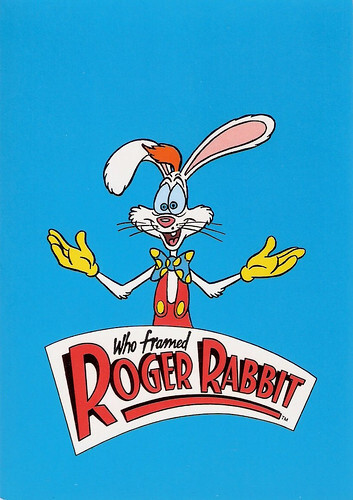
Belgian postcard by Rozenco, Brussels. Image: The Walt Disney Company / Amblin Entertainment, 1987. Publicity for Who Framed Roger Rabbit (Robert Zemeckis, 1988).
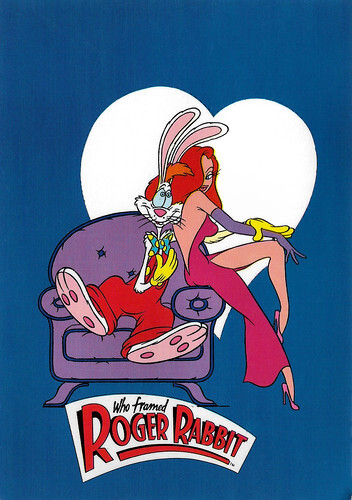
Belgian postcard by Rozenco, Brussels. Image: The Walt Disney Company / Amblin Entertainment, 1987. Publicity for Who Framed Roger Rabbit (Robert Zemeckis, 1988).
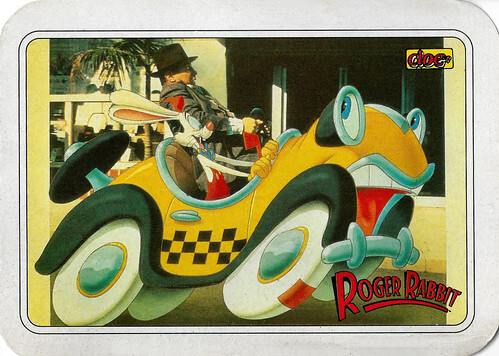
Italian postcard by Edizioni Cioe', Torino. Bob Hoskins in Who Framed Roger Rabbit (Robert Zemeckis, 1988).
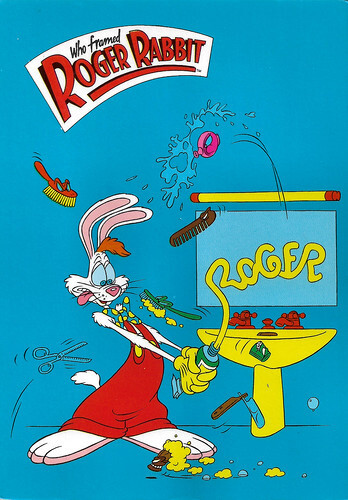
Belgian postcard by Rozenco, Brussels. Image: The Walt Disney Company and Amblin Entertainment Inc. Publicity for Who Framed Roger Rabbit (Robert Zemeckis, 1988).
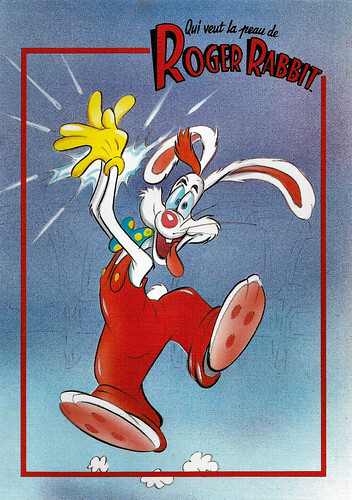
French postcard by M.D., Paris, no. D 630, 5/3. Image: Disney. Publicity for Who Framed Roger Rabbit (Robert Zemeckis, 1988). The French film title is Qui veut la peau de Roger Rabbit.
The Culprit of Toontown
Who Framed Roger Rabbit (Robert Zemeckis, 1988) is set in 1947 in Los Angeles. In the reality in which the film is set, cartoon characters called "Toons" live in the same world as "real" characters.
A part of Los Angeles is given entirely to them and is known as Toontown. They earn their living by acting in cartoons. One of the best-known Toons is the rabbit Roger Rabbit, who is the star of his cartoon series.
Lately, however, he has been unable to concentrate on his work. To find out why, R.K. Maroon, the studio boss and owner of Maroon Cartoons, hires cranky private detective Eddie Valiant (Bob Hoskins). Eddie was once one of Hollywood's best-known detectives. He and his brother Teddy helped hundreds of Toons with their problems.
Since Teddy was murdered by a Toon several years ago, Eddie has started drinking heavily and harbours a deep antipathy towards cartoon characters. He therefore reluctantly takes the job because he needs money to repay his debt to his barmaid and friend Dolores.
Soon, Eddie obtains photographic evidence that Roger's wife, Jessica Rabbit (who, unlike her name suggests, is not a rabbit but drawn as a human), is having an "affair" with Marvin Acme, the owner of the Acme Company and Toontown. When Roger discovers this, he is furious and vows to get his wife back. The next day, Marvin turns out to have been murdered, and Roger appears to be the culprit.
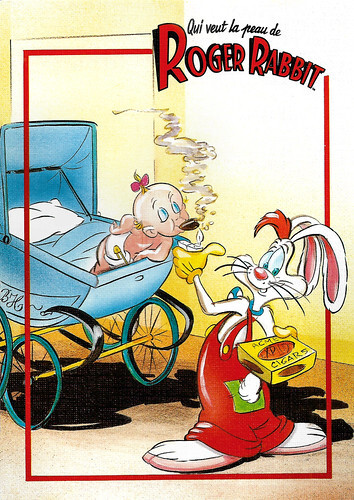
French postcard by M.D., Paris, no. D 630, 5/2. Image: Disney. Publicity for Who Framed Roger Rabbit (Robert Zemeckis, 1988). The French film title is Qui veut la peau de Roger Rabbit.
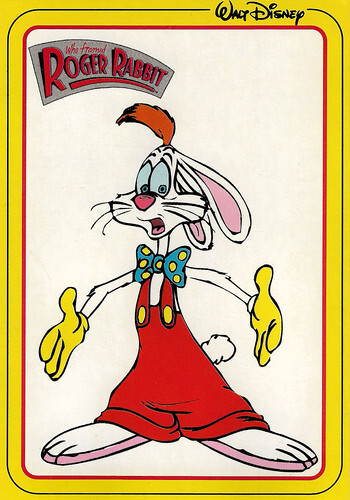
Italian postcard by Grafiche Biondetti S.R.L., Verona, no. 148/1. Image: Walt Disney. Publicity for Who Framed Roger Rabbit (Robert Zemeckis, 1988).
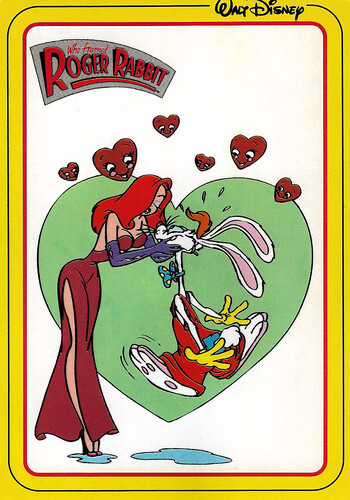
Italian postcard by Grafiche Biondetti S.R.L., Verona, no. 148/2. Image: Walt Disney. Publicity for Who Framed Roger Rabbit (Robert Zemeckis, 1988).
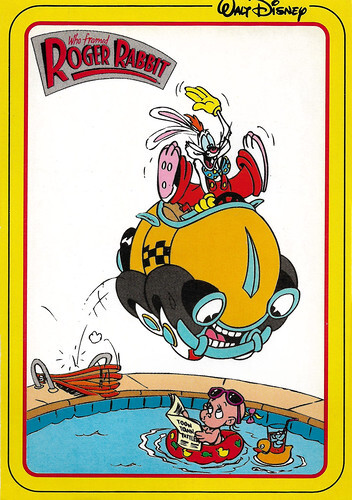
Italian postcard by Grafiche Biondetti S.R.L., Verona, no. 148/3. Image: Walt Disney. Publicity for Who Framed Roger Rabbit (Robert Zemeckis, 1988).
A homage to the cartoons of the 1940s
Who Framed Roger Rabbit (Robert Zemeckis, 1988) was inspired by the novel 'Who Censored Roger Rabbit?' which Disney had bought the rights to in 1981. Disney films had not been successful for some time and the company had seriously considered quitting. However, this film would change that.
Steven Spielberg managed to convince rival studios to let their cartoon characters act together in the same film. The condition was that they would be positioned equally. The live-action scenes were directed by Robert Zemeckis. The indoor scenes were mostly shot at the Cannon Elstree film studios in Hertfordshire, England. The outdoor scenes were shot on location in Los Angeles.
Although Disney was the studio behind the film, most of the animation was done in London. More than 100 individual pieces of film were optically combined to combine the animated and live-action scenes. The animated characters were drawn by hand and analogue optical effects such as shadows were added afterwards to give the cartoon characters a more 3D look.
The film was made at a time when digital animation was in its infancy. It was considered to make use of this but as the film was to be an homage to the cartoons of the 1940s (its heyday), hand-drawn cartoons were chosen. Walt Disney had already made a hybrid animation film (a combination of animation and live-action) with Mary Poppins (Robert Stevenson, 1964), but in this film, the scenes were very limited.
With Roger Rabbit, they went a step further. Almost half of the film consisted of hybrid scenes, there was much more physical interaction between people, cartoon characters and objects, and to make it even more difficult, the camera did not stay in a fixed position but moved along with the scenes. Who Framed Roger Rabbit was a huge success and made animated films popular again with the general public.
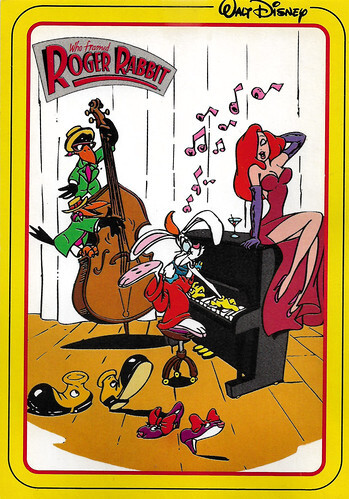
Italian postcard by Grafiche Biondetti S.R.L., Verona, no. 148/4. Image: Walt Disney. Publicity for Who Framed Roger Rabbit (Robert Zemeckis, 1988).
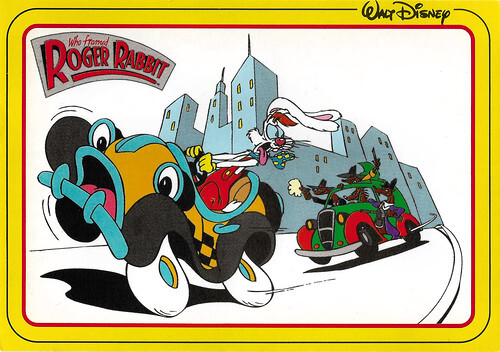
Italian postcard by Grafiche Biondetti S.R.L., Verona, no. 148/5. Image: Walt Disney. Publicity for Who Framed Roger Rabbit (Robert Zemeckis, 1988).
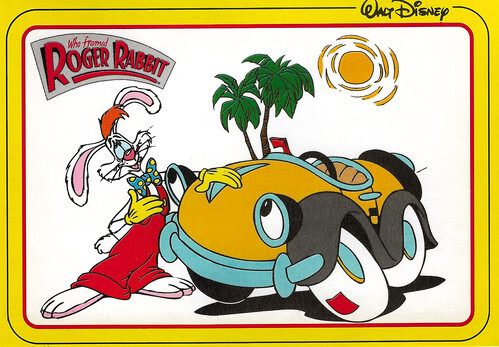
Italian postcard by Grafiche Biondetti S.R.L., Verona, no. 148/6. Image: Walt Disney. Publicity for Who Framed Roger Rabbit (Robert Zemeckis, 1988).
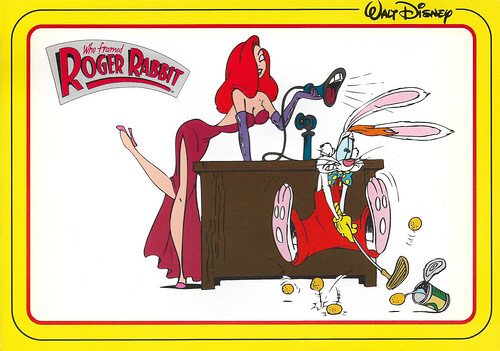
Italian postcard by Grafiche Biondetti S.R.L., Verona, no. 32. Image: Walt Disney. Publicity for Who Framed Roger Rabbit (Robert Zemeckis, 1988).
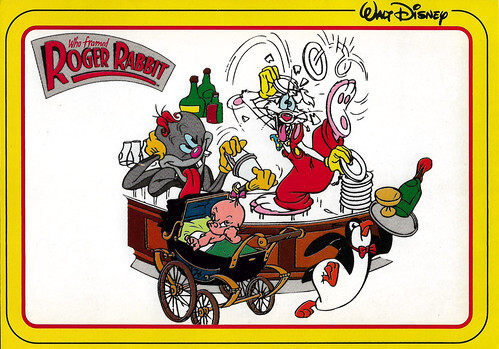
Italian postcard by Grafiche Biondetti S.R.L., Verona, no. 148/8. Image: Walt Disney. Publicity for Who Framed Roger Rabbit (Robert Zemeckis, 1988).
Sources: Wikipedia (Dutch and English) and IMDb.

Belgian postcard by Rozenco, Brussels. Image: The Walt Disney Company / Amblin Entertainment, 1987. Publicity for Who Framed Roger Rabbit (Robert Zemeckis, 1988).

Belgian postcard by Rozenco, Brussels. Image: The Walt Disney Company / Amblin Entertainment, 1987. Publicity for Who Framed Roger Rabbit (Robert Zemeckis, 1988).

Italian postcard by Edizioni Cioe', Torino. Bob Hoskins in Who Framed Roger Rabbit (Robert Zemeckis, 1988).

Belgian postcard by Rozenco, Brussels. Image: The Walt Disney Company and Amblin Entertainment Inc. Publicity for Who Framed Roger Rabbit (Robert Zemeckis, 1988).

French postcard by M.D., Paris, no. D 630, 5/3. Image: Disney. Publicity for Who Framed Roger Rabbit (Robert Zemeckis, 1988). The French film title is Qui veut la peau de Roger Rabbit.
The Culprit of Toontown
Who Framed Roger Rabbit (Robert Zemeckis, 1988) is set in 1947 in Los Angeles. In the reality in which the film is set, cartoon characters called "Toons" live in the same world as "real" characters.
A part of Los Angeles is given entirely to them and is known as Toontown. They earn their living by acting in cartoons. One of the best-known Toons is the rabbit Roger Rabbit, who is the star of his cartoon series.
Lately, however, he has been unable to concentrate on his work. To find out why, R.K. Maroon, the studio boss and owner of Maroon Cartoons, hires cranky private detective Eddie Valiant (Bob Hoskins). Eddie was once one of Hollywood's best-known detectives. He and his brother Teddy helped hundreds of Toons with their problems.
Since Teddy was murdered by a Toon several years ago, Eddie has started drinking heavily and harbours a deep antipathy towards cartoon characters. He therefore reluctantly takes the job because he needs money to repay his debt to his barmaid and friend Dolores.
Soon, Eddie obtains photographic evidence that Roger's wife, Jessica Rabbit (who, unlike her name suggests, is not a rabbit but drawn as a human), is having an "affair" with Marvin Acme, the owner of the Acme Company and Toontown. When Roger discovers this, he is furious and vows to get his wife back. The next day, Marvin turns out to have been murdered, and Roger appears to be the culprit.

French postcard by M.D., Paris, no. D 630, 5/2. Image: Disney. Publicity for Who Framed Roger Rabbit (Robert Zemeckis, 1988). The French film title is Qui veut la peau de Roger Rabbit.

Italian postcard by Grafiche Biondetti S.R.L., Verona, no. 148/1. Image: Walt Disney. Publicity for Who Framed Roger Rabbit (Robert Zemeckis, 1988).

Italian postcard by Grafiche Biondetti S.R.L., Verona, no. 148/2. Image: Walt Disney. Publicity for Who Framed Roger Rabbit (Robert Zemeckis, 1988).

Italian postcard by Grafiche Biondetti S.R.L., Verona, no. 148/3. Image: Walt Disney. Publicity for Who Framed Roger Rabbit (Robert Zemeckis, 1988).
A homage to the cartoons of the 1940s
Who Framed Roger Rabbit (Robert Zemeckis, 1988) was inspired by the novel 'Who Censored Roger Rabbit?' which Disney had bought the rights to in 1981. Disney films had not been successful for some time and the company had seriously considered quitting. However, this film would change that.
Steven Spielberg managed to convince rival studios to let their cartoon characters act together in the same film. The condition was that they would be positioned equally. The live-action scenes were directed by Robert Zemeckis. The indoor scenes were mostly shot at the Cannon Elstree film studios in Hertfordshire, England. The outdoor scenes were shot on location in Los Angeles.
Although Disney was the studio behind the film, most of the animation was done in London. More than 100 individual pieces of film were optically combined to combine the animated and live-action scenes. The animated characters were drawn by hand and analogue optical effects such as shadows were added afterwards to give the cartoon characters a more 3D look.
The film was made at a time when digital animation was in its infancy. It was considered to make use of this but as the film was to be an homage to the cartoons of the 1940s (its heyday), hand-drawn cartoons were chosen. Walt Disney had already made a hybrid animation film (a combination of animation and live-action) with Mary Poppins (Robert Stevenson, 1964), but in this film, the scenes were very limited.
With Roger Rabbit, they went a step further. Almost half of the film consisted of hybrid scenes, there was much more physical interaction between people, cartoon characters and objects, and to make it even more difficult, the camera did not stay in a fixed position but moved along with the scenes. Who Framed Roger Rabbit was a huge success and made animated films popular again with the general public.

Italian postcard by Grafiche Biondetti S.R.L., Verona, no. 148/4. Image: Walt Disney. Publicity for Who Framed Roger Rabbit (Robert Zemeckis, 1988).

Italian postcard by Grafiche Biondetti S.R.L., Verona, no. 148/5. Image: Walt Disney. Publicity for Who Framed Roger Rabbit (Robert Zemeckis, 1988).

Italian postcard by Grafiche Biondetti S.R.L., Verona, no. 148/6. Image: Walt Disney. Publicity for Who Framed Roger Rabbit (Robert Zemeckis, 1988).

Italian postcard by Grafiche Biondetti S.R.L., Verona, no. 32. Image: Walt Disney. Publicity for Who Framed Roger Rabbit (Robert Zemeckis, 1988).

Italian postcard by Grafiche Biondetti S.R.L., Verona, no. 148/8. Image: Walt Disney. Publicity for Who Framed Roger Rabbit (Robert Zemeckis, 1988).
Sources: Wikipedia (Dutch and English) and IMDb.
Published on December 12, 2023 22:00
December 11, 2023
J. Farrell MacDonald
J. Farrell MacDonald (1875-1952) was an American film and theatre actor and silent film director. Between 1911 and 1951, the character actor appeared in some 325 films, including 25 productions directed by John Ford alone. MacDonald also directed over 50 silent films between 1912 and 1917.
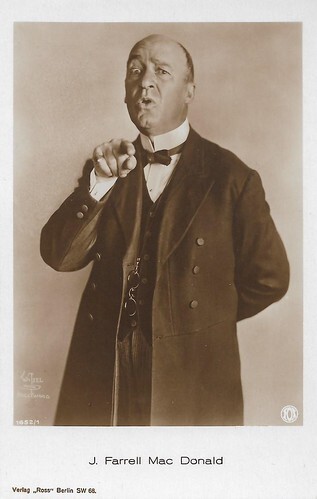
German postcard by Ross Verlag, Berlin, no. 1652/1, 1927-1928. Photo: Witzel, Hollywood / Fox.
Among the most popular character actors in Hollywood
J. Farrell MacDonald was born in 1875 in Waterbury, Connecticut. He began his career singing in minstrel shows, despite a degree from Yale University. After years of touring the United States with theatre troupes, he made his first film appearance in 1911 with film pioneer Carl Laemmle's production company IMP. After he had worked as an actor in numerous films, he also got directing jobs from 1912.
He was a director of more than 50 movies between 1912 and 1917, among them some quite lavish productions of their time. L. Frank Baum had MacDonald film his book 'The Wizard of Oz' in several parts, including The Patchwork Girl of Oz (J. Farrell MacDonald, 1914) and His Majesty, the Scarecrow of Oz (J. Farrell MacDonald, 1914). Harold Lloyd and Hal Roach got their first acting and extra roles through MacDonald when they were both still completely unknown.
Later, when Roach had founded his own film studio with Lloyd as his main star, they brought MacDonald in temporarily as director. In parallel with his directing work, however, MacDonald continued to appear in films as an actor, and by 1918 he was among the most popular character actors in Hollywood. He ended his career as a director to work exclusively as an actor.
In 1919, J. Farrell MacDonald made his first film with John Ford called A Fight for Love, and they made three more films together that same year. Ford and MacDonald would make a total of 25 films together over the decades. In the 1920s, MacDonald appeared in Ford's films The Iron Horse (1924), Kentucky Pride (1925), The Fighting Heart (1925) and 3 Bad Men (1926) in which he was one of the three, together with Tom Santschi and Frank Campeau.
The German director Friedrich Wilhelm Murnau used him as the friendly photographer in Sunrise (1927) and the clown in the lost film 4 Devils (1928). MacDonald also starred in many late silent comedies such as Ford's Riley the Cop (John Ford, 1928) in which he played the title role, The Cohens and the Kellys in Paris (William Beaudine, 1928) in which he co-starred with George Sidney, and Bringing Up Father (Jack Conway, 1928) in which he had the title role again, opposite Marie Dressler .
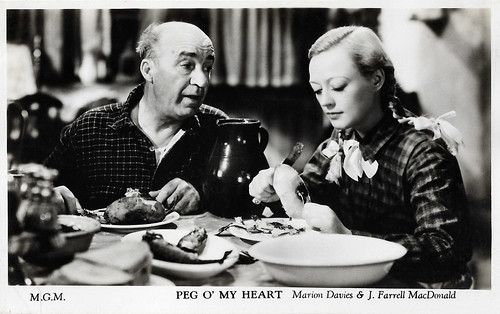
British postcard by Film Weekly. Photo: M.G.M. Marion Davies and J. Farrell MacDonald in the Pre-Code movie Peg O'My Heart (Robert Z. Leonard, 1933). Marion Davies stars as a poor Irish girl who stands to inherit a fortune if she satisfies certain conditions. She is taken away from her father (MacDonald) and brought to the posh estate of her late grandfather. Within three years she has to learn to become a lady.
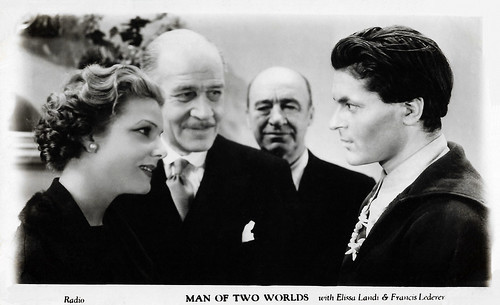
British postcard in the Film Shots series by Film Weekly. Photo: Radio (RKO). Elissa Landi , Henry Stephenson and Francis Lederer in Man of Two Worlds (J. Walter Ruben, 1934). In the background J. Farrell MacDonald.
Tugboat captains, policemen, military men or judges
With the advent of the talkies, J. Farrell MacDonald remained a busy and well-known actor in major supporting parts in such films as The Painted Desert (Howard Higgin, Tom Buckingham, 1931) with William Boyd and William Farnum , The Phantom Express (Emory Johnson, 1932) with William Collier jr., Peg O' My Heart (Robert Z. Leonard, 1933) with Marion Davies , Murder on the Campus (Richard Thorpe, 1933) with Charles Starrett, Beggar's Holiday (Sam Newfield, 1934) with Sally O'Neill , Waterfront Lady (Joseph Santley, 1935) with Ann Rutherford, and Stormy (Lew Landers, 1935) with Jean Rogers.
Still, overall, his roles became increasingly smaller. He often played paternal or stern-seeming workers, tugboat captains, policemen, military men or judges; frequently in Westerns or crime films. In the 1930s and 1940s, he was used by Frank Capra, Hal Roach, John Ford and in particular Preston Sturges, with whom he did seven films including Sullivan's Travels (1941).
A last lead he had in The Last Alarm (William Beaudine, 1940), a Monogram production about a retired chief of the Fire Department who finds and unmasks an arsonist. Yet, from about 1940, MacDonald was increasingly uncredited for his small roles, including his appearance as an enraged man whose tree James Stewart drives into in It's a Wonderful Life (Frank Capra, 1946).
One of his last major roles was as the innkeeper in John Ford's My Darling Clementine in 1946. He also made a few television appearances in his last years. He worked as an actor until his death. For a time, MacDonald also taught acting at the University of Southern California.
J. Farrell MacDonald was married to the actress Edith Bostwick (1882-1943) until her death in 1943. They had one daughter. MacDonald died in 1952 in Hollywood, California, at the age of 77 and is buried in the Chapel of the Pines Crematory in Los Angeles.
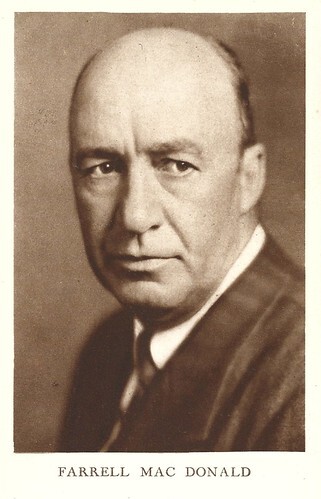
Belgian postcard/ collector's card. Weekblad Cinema, Antwerpen.
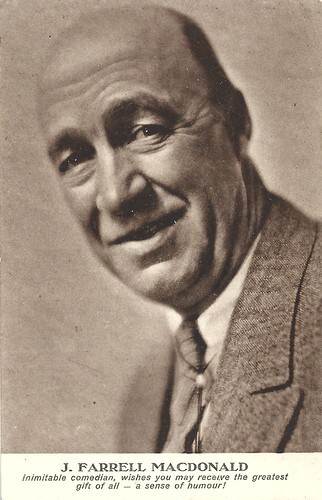
British promotional postcard. "J. Farrell MacDonald stars in the following Fox Films: The First Year, The Shamrock Handicap, A Trip to Chinatown, 3 Bad Men, The Family Upstairs, The Country Beyond. All showmen should book these." All these film titles date from 1926.
Sources: Wikipedia (German and English) and .

German postcard by Ross Verlag, Berlin, no. 1652/1, 1927-1928. Photo: Witzel, Hollywood / Fox.
Among the most popular character actors in Hollywood
J. Farrell MacDonald was born in 1875 in Waterbury, Connecticut. He began his career singing in minstrel shows, despite a degree from Yale University. After years of touring the United States with theatre troupes, he made his first film appearance in 1911 with film pioneer Carl Laemmle's production company IMP. After he had worked as an actor in numerous films, he also got directing jobs from 1912.
He was a director of more than 50 movies between 1912 and 1917, among them some quite lavish productions of their time. L. Frank Baum had MacDonald film his book 'The Wizard of Oz' in several parts, including The Patchwork Girl of Oz (J. Farrell MacDonald, 1914) and His Majesty, the Scarecrow of Oz (J. Farrell MacDonald, 1914). Harold Lloyd and Hal Roach got their first acting and extra roles through MacDonald when they were both still completely unknown.
Later, when Roach had founded his own film studio with Lloyd as his main star, they brought MacDonald in temporarily as director. In parallel with his directing work, however, MacDonald continued to appear in films as an actor, and by 1918 he was among the most popular character actors in Hollywood. He ended his career as a director to work exclusively as an actor.
In 1919, J. Farrell MacDonald made his first film with John Ford called A Fight for Love, and they made three more films together that same year. Ford and MacDonald would make a total of 25 films together over the decades. In the 1920s, MacDonald appeared in Ford's films The Iron Horse (1924), Kentucky Pride (1925), The Fighting Heart (1925) and 3 Bad Men (1926) in which he was one of the three, together with Tom Santschi and Frank Campeau.
The German director Friedrich Wilhelm Murnau used him as the friendly photographer in Sunrise (1927) and the clown in the lost film 4 Devils (1928). MacDonald also starred in many late silent comedies such as Ford's Riley the Cop (John Ford, 1928) in which he played the title role, The Cohens and the Kellys in Paris (William Beaudine, 1928) in which he co-starred with George Sidney, and Bringing Up Father (Jack Conway, 1928) in which he had the title role again, opposite Marie Dressler .

British postcard by Film Weekly. Photo: M.G.M. Marion Davies and J. Farrell MacDonald in the Pre-Code movie Peg O'My Heart (Robert Z. Leonard, 1933). Marion Davies stars as a poor Irish girl who stands to inherit a fortune if she satisfies certain conditions. She is taken away from her father (MacDonald) and brought to the posh estate of her late grandfather. Within three years she has to learn to become a lady.

British postcard in the Film Shots series by Film Weekly. Photo: Radio (RKO). Elissa Landi , Henry Stephenson and Francis Lederer in Man of Two Worlds (J. Walter Ruben, 1934). In the background J. Farrell MacDonald.
Tugboat captains, policemen, military men or judges
With the advent of the talkies, J. Farrell MacDonald remained a busy and well-known actor in major supporting parts in such films as The Painted Desert (Howard Higgin, Tom Buckingham, 1931) with William Boyd and William Farnum , The Phantom Express (Emory Johnson, 1932) with William Collier jr., Peg O' My Heart (Robert Z. Leonard, 1933) with Marion Davies , Murder on the Campus (Richard Thorpe, 1933) with Charles Starrett, Beggar's Holiday (Sam Newfield, 1934) with Sally O'Neill , Waterfront Lady (Joseph Santley, 1935) with Ann Rutherford, and Stormy (Lew Landers, 1935) with Jean Rogers.
Still, overall, his roles became increasingly smaller. He often played paternal or stern-seeming workers, tugboat captains, policemen, military men or judges; frequently in Westerns or crime films. In the 1930s and 1940s, he was used by Frank Capra, Hal Roach, John Ford and in particular Preston Sturges, with whom he did seven films including Sullivan's Travels (1941).
A last lead he had in The Last Alarm (William Beaudine, 1940), a Monogram production about a retired chief of the Fire Department who finds and unmasks an arsonist. Yet, from about 1940, MacDonald was increasingly uncredited for his small roles, including his appearance as an enraged man whose tree James Stewart drives into in It's a Wonderful Life (Frank Capra, 1946).
One of his last major roles was as the innkeeper in John Ford's My Darling Clementine in 1946. He also made a few television appearances in his last years. He worked as an actor until his death. For a time, MacDonald also taught acting at the University of Southern California.
J. Farrell MacDonald was married to the actress Edith Bostwick (1882-1943) until her death in 1943. They had one daughter. MacDonald died in 1952 in Hollywood, California, at the age of 77 and is buried in the Chapel of the Pines Crematory in Los Angeles.

Belgian postcard/ collector's card. Weekblad Cinema, Antwerpen.

British promotional postcard. "J. Farrell MacDonald stars in the following Fox Films: The First Year, The Shamrock Handicap, A Trip to Chinatown, 3 Bad Men, The Family Upstairs, The Country Beyond. All showmen should book these." All these film titles date from 1926.
Sources: Wikipedia (German and English) and .
Published on December 11, 2023 22:00
December 10, 2023
Marisa Pavan (1932-2023)
Italian-born actress Marisa Pavan (1932) passed away on 6 December 2023. She first became famous as the twin sister to film star Pier Angeli before achieving film stardom on her own. The docile actress became known for her gentle, understated roles. She won the Golden Globe and was Oscar-nominated for her supporting turn in The Rose Tattoo (1955). Marisa Pavan was the wife of French film star Jean-Pierre Aumont.
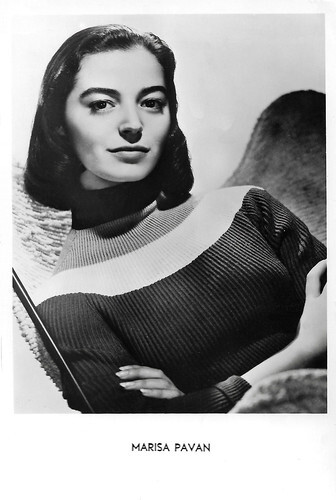
Belgian postcard, no. 51.
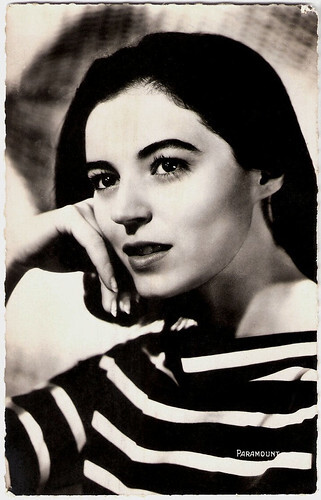
French postcard by Editions du Globe (E.D.U.G.), no. 532. Photo: International Press / Paramount.
Twin sister
Marisa Pavan was born Marisa Pierangeli in Cagliari, Sardinia, Italy, in 1932. Her twin sister was Anna Maria Pierangeli, who later became film star Pier Angeli . They were fraternal twins with different personalities as well. Anna Maria was dreamy and innocent; Maria Luisa was independent and studious. They were the children of Enrichetta (née Romiti) and Luigi Pierangeli, a construction engineer. The two girls also had a younger sister, Patrizia Pierangeli, who became an actress as well.
They moved to Rome in the late 1940s. In 1948 their lives changed when director Vittorio De Sica cast Anna in Domani è troppo tardi/Tomorrow Is Too Late (Léonide Moguy, 1950). In 1950 the family moved to Hollywood, where Anna Maria changed her name to Pier Angeli . Marisa studied briefly at Torquado Tasso College and made her first film appearance in an Italian satire of the Cold War, Ho Scelto L'Amore/I Chose Love (Mario Zampi, 1952), before coming with her family to the United States.
Marisa had no dramatic training and was not really interested in acting when she signed a Hollywood contract with Paramount at age 19. She made her American debut playing a sweet village girl in What Price Glory? (John Ford, 1952), 20th Century Fox's remake of the 1926 classic. She changed her last name to Pavan, the name of a Jewish officer her family had hidden from the Nazis during World War 2.
She then impressed as a blind witness to a murder in the Film Noir Down Three Dark Streets (Arnold Laven, 1953) opposite Broderick Crawford . She then appeared opposite Alan Ladd in the Western Drum Beat (Delmer Daves, 1954).
Her breakthrough came in the film The Rose Tattoo (Daniel Mann, 1955) as Anna Magnani 's teen-age daughter. Her role was first assigned to her twin, who at the time was unable to play the part. When Magnani won the Oscar for Best Actress, Pavan accepted on her behalf as Magnani was not present at the awards ceremony. Pavan was nominated for Best Supporting Actress, losing to Jo Van Fleet for East of Eden (Elia Kazan, 1955). Both Magnani and Pavan won Golden Globe awards that year.
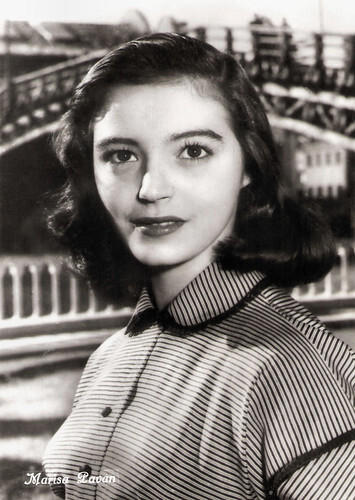
Italian postcard by Vetta Traldi, Milano, in the 'Divi del Cinema' series, no. 41.
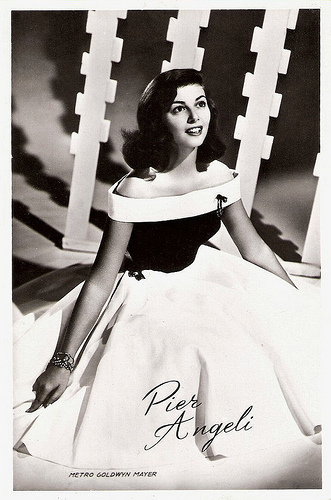
Pier Angeli . Dutch postcard by Takken, Utrecht, no. 1182. Photo: MGM.
Jean-Pierre Aumont
Marisa Pavan co-starred in several more Hollywood films, usually in gentle roles. She played the Native American childhood sweetheart of Alan Ladd in Drum Beat (Delmer Daves, 1954).
Pavan appeared as the scheming Catherine de Medici in the opulent costume drama Diane (David Miller, 1955) starring Lana Turner , and she had an illegitimate child with Gregory Peck in The Man in the Grey Flannel Suit (Nunnally Johnson, 1956).
In 1956, she married, later divorced, and then again remarried the French actor Jean-Pierre Aumont .
In the following years she appeared opposite Tony Curtis in the Film Noir The Midnight Story (Joseph Pevney, 1957) as the leading lady to Robert Stack in the sea-faring historical epic John Paul Jones (John Farrow, 1959), and Abishag in the Biblical film adaptation Solomon and Sheba (King Vidor, 1959).
Her Hollywood days ended with the dawn of the 1960s. With her husband, she sang in a supper club act that toured the United States, Canada and Mexico. She acted in several American TV productions, including The Diary of Anne Frank (Alex Segal, 1967) with Max von Sydow, Cutter's Trail (Vincent McEveety, 1970) with John Saxon , The Moneychangers (Boris Sagal, 1976) starring Kirk Douglas , and The Trial of Lee Harvey Oswald (Gordon Davidson, David Greene, 1977).
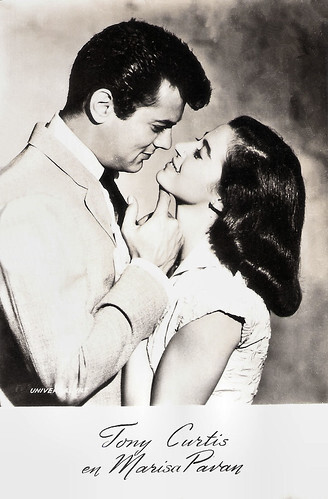
Dutch postcard by Uitg. Takken, Utrecht, no. 3144. Photo: Universal Int. Marisa Pavan and Tony Curtis in The Midnight Story (Joseph Pevney, 1957).
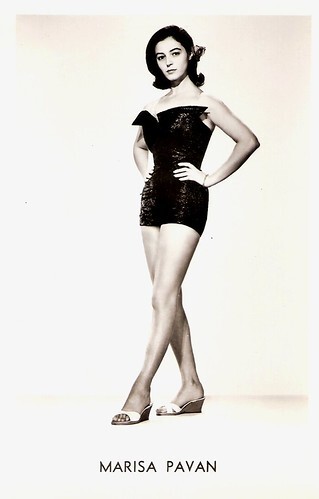
Dutch postcard, no. 2037.
Hit record
Marisa Pavan returned to Europe and appeared in the French films L’Evenement Le Plus Important Depuis Que L’homme A Marche Sur La Lune/A Slightly Pregnant Man (Jacques Demy, 1973) starring Marcello Mastroianni , and the romance Antoine et Sebastien (Jean-Marie Perier, 1974) with Jacques Dutronc .
She had a hit record in 1974 with a French-language version of Burt Bacharach's 'Green Grass Starts to Grow'. Later she guest-starred in episodes of popular American TV series like The Rockford Files (1979), Hawaii Five-O (1977), McMillan & Wife (1977) and Ryan's Hope (1985).
In 1983 she was interviewed for Stelle Emigranti/Wandering Stars (Francesco Bortolini, Claudio Masenza, 1983), a revealing documentary about eight Italian actresses, including Gina Lollobrigida , Claudia Cardinale and Virna Lisi , who attained worldwide fame through films they made in Hollywood. Most of the eight agree that performers are treated better in Hollywood than in Italy and that American efficiency and organisation impressed them - but that in Italy, they had more challenging roles than was allowed in the USA.
Pavan was the founder and director of URMA (Unis pour la Recherche sur la Maladie d'Alzheimer), an organisation she created to support research working to find treatments for Alzheimer's.
With Aumont, she appeared for the last time together in the French TV film Johnny Monroe (Renaud Saint-Pierre, 1987). After Jean-Pierre Aumont died in 2001, Pavan lived in Paris. They had two sons, Jean-Claude and Patrick. Marisa Pavan was also the stepmother of actress Tina Aumont . Pavan died at her home in Gassin, France on 6 December 2023, at the age of 91.
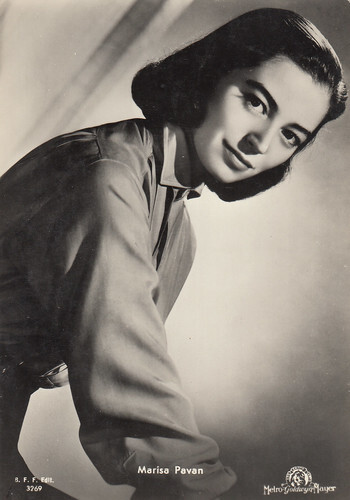
Italian postcard by B.F.F., Firenze, no. 3269. Photo: Metro Goldwyn Mayer. Collection: Marlene Pilaete.
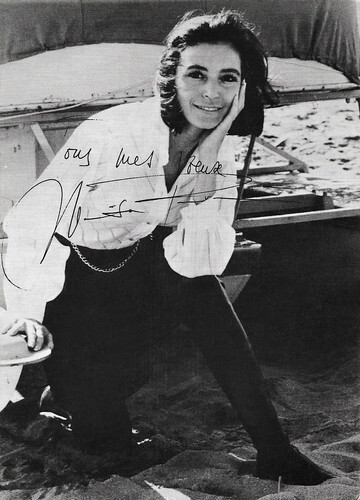
French postcard by La Roue Tourne, Paris.
Sources: Hal Erickson (AllMovie), Wikipedia and .

Belgian postcard, no. 51.

French postcard by Editions du Globe (E.D.U.G.), no. 532. Photo: International Press / Paramount.
Twin sister
Marisa Pavan was born Marisa Pierangeli in Cagliari, Sardinia, Italy, in 1932. Her twin sister was Anna Maria Pierangeli, who later became film star Pier Angeli . They were fraternal twins with different personalities as well. Anna Maria was dreamy and innocent; Maria Luisa was independent and studious. They were the children of Enrichetta (née Romiti) and Luigi Pierangeli, a construction engineer. The two girls also had a younger sister, Patrizia Pierangeli, who became an actress as well.
They moved to Rome in the late 1940s. In 1948 their lives changed when director Vittorio De Sica cast Anna in Domani è troppo tardi/Tomorrow Is Too Late (Léonide Moguy, 1950). In 1950 the family moved to Hollywood, where Anna Maria changed her name to Pier Angeli . Marisa studied briefly at Torquado Tasso College and made her first film appearance in an Italian satire of the Cold War, Ho Scelto L'Amore/I Chose Love (Mario Zampi, 1952), before coming with her family to the United States.
Marisa had no dramatic training and was not really interested in acting when she signed a Hollywood contract with Paramount at age 19. She made her American debut playing a sweet village girl in What Price Glory? (John Ford, 1952), 20th Century Fox's remake of the 1926 classic. She changed her last name to Pavan, the name of a Jewish officer her family had hidden from the Nazis during World War 2.
She then impressed as a blind witness to a murder in the Film Noir Down Three Dark Streets (Arnold Laven, 1953) opposite Broderick Crawford . She then appeared opposite Alan Ladd in the Western Drum Beat (Delmer Daves, 1954).
Her breakthrough came in the film The Rose Tattoo (Daniel Mann, 1955) as Anna Magnani 's teen-age daughter. Her role was first assigned to her twin, who at the time was unable to play the part. When Magnani won the Oscar for Best Actress, Pavan accepted on her behalf as Magnani was not present at the awards ceremony. Pavan was nominated for Best Supporting Actress, losing to Jo Van Fleet for East of Eden (Elia Kazan, 1955). Both Magnani and Pavan won Golden Globe awards that year.

Italian postcard by Vetta Traldi, Milano, in the 'Divi del Cinema' series, no. 41.

Pier Angeli . Dutch postcard by Takken, Utrecht, no. 1182. Photo: MGM.
Jean-Pierre Aumont
Marisa Pavan co-starred in several more Hollywood films, usually in gentle roles. She played the Native American childhood sweetheart of Alan Ladd in Drum Beat (Delmer Daves, 1954).
Pavan appeared as the scheming Catherine de Medici in the opulent costume drama Diane (David Miller, 1955) starring Lana Turner , and she had an illegitimate child with Gregory Peck in The Man in the Grey Flannel Suit (Nunnally Johnson, 1956).
In 1956, she married, later divorced, and then again remarried the French actor Jean-Pierre Aumont .
In the following years she appeared opposite Tony Curtis in the Film Noir The Midnight Story (Joseph Pevney, 1957) as the leading lady to Robert Stack in the sea-faring historical epic John Paul Jones (John Farrow, 1959), and Abishag in the Biblical film adaptation Solomon and Sheba (King Vidor, 1959).
Her Hollywood days ended with the dawn of the 1960s. With her husband, she sang in a supper club act that toured the United States, Canada and Mexico. She acted in several American TV productions, including The Diary of Anne Frank (Alex Segal, 1967) with Max von Sydow, Cutter's Trail (Vincent McEveety, 1970) with John Saxon , The Moneychangers (Boris Sagal, 1976) starring Kirk Douglas , and The Trial of Lee Harvey Oswald (Gordon Davidson, David Greene, 1977).

Dutch postcard by Uitg. Takken, Utrecht, no. 3144. Photo: Universal Int. Marisa Pavan and Tony Curtis in The Midnight Story (Joseph Pevney, 1957).

Dutch postcard, no. 2037.
Hit record
Marisa Pavan returned to Europe and appeared in the French films L’Evenement Le Plus Important Depuis Que L’homme A Marche Sur La Lune/A Slightly Pregnant Man (Jacques Demy, 1973) starring Marcello Mastroianni , and the romance Antoine et Sebastien (Jean-Marie Perier, 1974) with Jacques Dutronc .
She had a hit record in 1974 with a French-language version of Burt Bacharach's 'Green Grass Starts to Grow'. Later she guest-starred in episodes of popular American TV series like The Rockford Files (1979), Hawaii Five-O (1977), McMillan & Wife (1977) and Ryan's Hope (1985).
In 1983 she was interviewed for Stelle Emigranti/Wandering Stars (Francesco Bortolini, Claudio Masenza, 1983), a revealing documentary about eight Italian actresses, including Gina Lollobrigida , Claudia Cardinale and Virna Lisi , who attained worldwide fame through films they made in Hollywood. Most of the eight agree that performers are treated better in Hollywood than in Italy and that American efficiency and organisation impressed them - but that in Italy, they had more challenging roles than was allowed in the USA.
Pavan was the founder and director of URMA (Unis pour la Recherche sur la Maladie d'Alzheimer), an organisation she created to support research working to find treatments for Alzheimer's.
With Aumont, she appeared for the last time together in the French TV film Johnny Monroe (Renaud Saint-Pierre, 1987). After Jean-Pierre Aumont died in 2001, Pavan lived in Paris. They had two sons, Jean-Claude and Patrick. Marisa Pavan was also the stepmother of actress Tina Aumont . Pavan died at her home in Gassin, France on 6 December 2023, at the age of 91.

Italian postcard by B.F.F., Firenze, no. 3269. Photo: Metro Goldwyn Mayer. Collection: Marlene Pilaete.

French postcard by La Roue Tourne, Paris.
Sources: Hal Erickson (AllMovie), Wikipedia and .
Published on December 10, 2023 22:00
December 9, 2023
Ryan O'Neal (1941-2023)
On Friday 8 December 2023, American actor Ryan O'Neal (1941) passed away. He was one of Hollywood's most successful stars during the 1970s and is probably best known for his role as Rodney Harrington in the legendary nighttime soap opera Peyton Place(1964-1969). He received an Oscar nomination for Best Actor for his role in Love Story (1970). Ryan O'Neal was further seen in the crime comedy Paper Moon (1973) alongside his daughter Tatum O'Neal, Stanley Kubrick's Barry Lyndon (1975) and the sequel Oliver's Story (1978). O'Neal was 82.

Vintage collectors card, no. 33. Ryan O'Neal in the TV series Peyton Place (1964-1969).
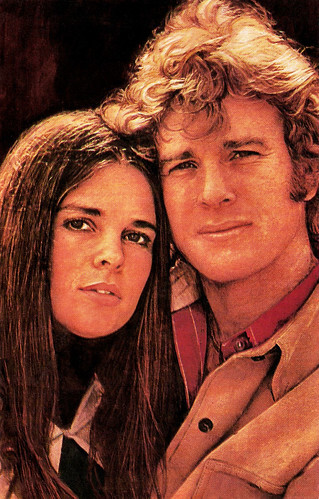
Romanian postcard by Casa Filmului Acin, no. 196. Ali McGraw and Ryan O'Neal in Love Story (Arthur Hiller, 1970).

Romanian postcard by Casa Filmului Acin, no. 434.
A box office phenomenon
Charles Samuel Eldridge Patrick Ryan O'Neal III was born in Los Angeles, California, in 1941. He was the eldest son of Irish-American Hollywood film screenwriter Charles O'Neal and actress Patricia Callaghan. The family moved frequently, and Ryan grew up in Mexico, England and Germany.
In West Los Angeles, O'Neal attended University High School and trained as an amateur boxer. He attended Munich American High School in Munich, where his parents worked on the American television series Tales of the Vikings (1959). The seventeen-year-old was hired as an extra and stuntman for the series. Back in the United States, O'Neal made his debut in the popular series The Many Loves of Dobie Gillis.
The 'pretty boy' also played in such series as The Untouchables, The Virginian and Perry Mason. In 1964, he landed the role of Rodney Harrington on the prime-time soap opera Peyton Place. It was an instant hit and boosted O'Neal's career. O'Neal's first lead in a feature came with The Big Bounce (Alex March, 1969), based on an Elmore Leonard novel.
In 1970, he played an Olympic athlete in the British sports drama The Games (Michael Winner, 1970). The film had been co-written by Erich Segal, who recommended O'Neal for the lead alongside Ali MacGraw in Love Story (Arthur Hiller, 1970) based on Segal's novel and script. Love Story turned out to be a box office phenomenon. For his role as Oliver, O'Neal received Academy Award and Golden Globe nominations as Best Actor.
O'Neal starred in several films by director Peter Bogdanovich, such as the screwball comedy What's Up, Doc? (Peter Bogdanovich, 1972) with Barbra Streisand . It was another big hit and O'Neal was the second most profitable movie star in 1972. Other successes were Paper Moon (Peter Bogdanovich, 1973) with his then ten-year-old daughter Tatum O'Neal, the historical film Barry Lyndon (Stanley Kubrick, 1975), and Nickelodeon (Peter Bogdanovich, 1976) with Burt Reynolds . The latter film flopped at the box office.
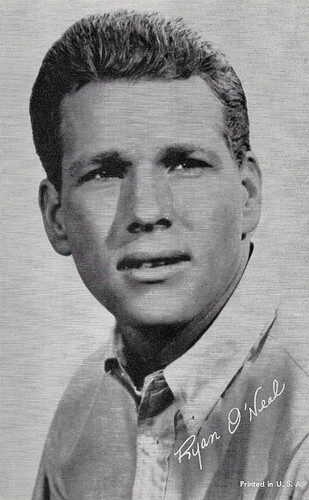
American Arcade card.

Belgian postcard by Raider Bounty / Joepie. Ali McGraw and Ryan O'Neal in Love Story (Arthur Hiller, 1970).

Big East-German card by VEB Progress Film-Verleih, Berlin, no. 7/82. Ryan O'Neal in Oliver's Story (John Korty, 1978).
Worst actor of the decade
Ryan O'Neal played US General Gavin in the all-star war film A Bridge Too Far (Richard Attenborough, 1977) about the Battle of Arnhem. The film was shot from May to August 1976 at locations in the Netherlands. O'Neal was excellent in the thriller The Driver (Walter Hill, 1978) with Isabelle Adjani and Bruce Dern. The film was not a commercial hit but gained a cult reputation through the years.
O'Neal played a boxer in a romantic comedy, The Main Event (Howard Zieff, 1979), reuniting him with Barbra Streisand . He received a fee of $1 million plus a percentage of the profits. The Main Event was a sizeable hit at the box office. In the early 1980s, however, O'Neal's career faltered. Partners (James Burrows, 1982) was a farce written by Francis Veber in which O'Neal played a straight cop who goes undercover as one half of a gay couple with John Hurt.
He then played a film director loosely based on Peter Bogdanovich in Irreconcilable Differences (Charles Shyer, 1984) with Shelley Long and Drew Barrymore . It was a minor box office success. However, the gambling drama Fever Pitch (Richard Brooks, 1985) was nominated in four categories at the 1985 Razzie Awards, and for which he was nominated at the 1989 Razzie Awards for 'Worst Actor of the Decade'. After a few more flops, he received no more cinema offers. Instead, he appeared in a series of television films with his partner Farrah Fawcett, such as in the dramatic TV film Small Sacrifices (David Greene, 1989). He had a good role in Faithful (Paul Mazursky, 1996) with Cher. From 2005 to 2017, he had a recurring role in the TV series Bones as Max Keenan, the father of the show's protagonist.
Since 1982, O'Neal had been in a relationship with Farrah Fawcett. They had a son, Redmond (1985). From his two previous marriages, O'Neal has three more children: with actress Joanna Cook Moore he has a daughter and a son, Tatum (1963) and Griffin (1964); with Leigh Taylor-Young he had a son, Patrick (1967), a sports commentator. In 1997, Fawcett and O'Neal separated. In 2001, O'Neal was diagnosed with CML, a form of leukaemia and Fawcett and O'Neal became close again. On 22 June 2009, O'Neal announced that he wanted to marry Fawcett, who was also seriously ill, but just three days later, Farrah Fawcett died of cancer in Los Angeles at the age of 62.
The relationships with his three eldest children were tense. In 2011, Tatum O'Neal reconciled with her father with a book and a TV show, 'Ryan and Tatum: The O'Neals'. In August of that year, O'Neal, Tatum, and Patrick attended Redmond's court appearance on firearms and drug charges. Redmond struggled with drug addiction for most of his adult life. Ryan O'Neal has five grandchildren: Kevin McEnroe, born in 1986, Sean McEnroe, born in 1987 and Emily McEnroe, born in 1991, whose mother is Tatum O'Neal. Patrick O'Neal is the father of Sophia De Mornay-O'Neal, born in 1997 and Veronica De Mornay-O'Neal, born in 2001. In 2016, Ryan O'Neal reunited with Love Story co-star Ali MacGraw in a staging of A.R. Gurney's play 'Love Letter'. In 2021, they received a star on the Hollywood Walk of Fame in a virtual double ceremony. Ryan O'Neal died in Los Angeles in 2023 at the age of 82.

Romanian postcard by Casa Filmului Acin. Ryan O'Neal in Love Story (Arthur Hiller, 1970).

Romanian postcard by Casa Filmului Acin, no. 593.
Source: Wikipedia (English, French, German and Dutch) and .

Vintage collectors card, no. 33. Ryan O'Neal in the TV series Peyton Place (1964-1969).

Romanian postcard by Casa Filmului Acin, no. 196. Ali McGraw and Ryan O'Neal in Love Story (Arthur Hiller, 1970).

Romanian postcard by Casa Filmului Acin, no. 434.
A box office phenomenon
Charles Samuel Eldridge Patrick Ryan O'Neal III was born in Los Angeles, California, in 1941. He was the eldest son of Irish-American Hollywood film screenwriter Charles O'Neal and actress Patricia Callaghan. The family moved frequently, and Ryan grew up in Mexico, England and Germany.
In West Los Angeles, O'Neal attended University High School and trained as an amateur boxer. He attended Munich American High School in Munich, where his parents worked on the American television series Tales of the Vikings (1959). The seventeen-year-old was hired as an extra and stuntman for the series. Back in the United States, O'Neal made his debut in the popular series The Many Loves of Dobie Gillis.
The 'pretty boy' also played in such series as The Untouchables, The Virginian and Perry Mason. In 1964, he landed the role of Rodney Harrington on the prime-time soap opera Peyton Place. It was an instant hit and boosted O'Neal's career. O'Neal's first lead in a feature came with The Big Bounce (Alex March, 1969), based on an Elmore Leonard novel.
In 1970, he played an Olympic athlete in the British sports drama The Games (Michael Winner, 1970). The film had been co-written by Erich Segal, who recommended O'Neal for the lead alongside Ali MacGraw in Love Story (Arthur Hiller, 1970) based on Segal's novel and script. Love Story turned out to be a box office phenomenon. For his role as Oliver, O'Neal received Academy Award and Golden Globe nominations as Best Actor.
O'Neal starred in several films by director Peter Bogdanovich, such as the screwball comedy What's Up, Doc? (Peter Bogdanovich, 1972) with Barbra Streisand . It was another big hit and O'Neal was the second most profitable movie star in 1972. Other successes were Paper Moon (Peter Bogdanovich, 1973) with his then ten-year-old daughter Tatum O'Neal, the historical film Barry Lyndon (Stanley Kubrick, 1975), and Nickelodeon (Peter Bogdanovich, 1976) with Burt Reynolds . The latter film flopped at the box office.

American Arcade card.

Belgian postcard by Raider Bounty / Joepie. Ali McGraw and Ryan O'Neal in Love Story (Arthur Hiller, 1970).

Big East-German card by VEB Progress Film-Verleih, Berlin, no. 7/82. Ryan O'Neal in Oliver's Story (John Korty, 1978).
Worst actor of the decade
Ryan O'Neal played US General Gavin in the all-star war film A Bridge Too Far (Richard Attenborough, 1977) about the Battle of Arnhem. The film was shot from May to August 1976 at locations in the Netherlands. O'Neal was excellent in the thriller The Driver (Walter Hill, 1978) with Isabelle Adjani and Bruce Dern. The film was not a commercial hit but gained a cult reputation through the years.
O'Neal played a boxer in a romantic comedy, The Main Event (Howard Zieff, 1979), reuniting him with Barbra Streisand . He received a fee of $1 million plus a percentage of the profits. The Main Event was a sizeable hit at the box office. In the early 1980s, however, O'Neal's career faltered. Partners (James Burrows, 1982) was a farce written by Francis Veber in which O'Neal played a straight cop who goes undercover as one half of a gay couple with John Hurt.
He then played a film director loosely based on Peter Bogdanovich in Irreconcilable Differences (Charles Shyer, 1984) with Shelley Long and Drew Barrymore . It was a minor box office success. However, the gambling drama Fever Pitch (Richard Brooks, 1985) was nominated in four categories at the 1985 Razzie Awards, and for which he was nominated at the 1989 Razzie Awards for 'Worst Actor of the Decade'. After a few more flops, he received no more cinema offers. Instead, he appeared in a series of television films with his partner Farrah Fawcett, such as in the dramatic TV film Small Sacrifices (David Greene, 1989). He had a good role in Faithful (Paul Mazursky, 1996) with Cher. From 2005 to 2017, he had a recurring role in the TV series Bones as Max Keenan, the father of the show's protagonist.
Since 1982, O'Neal had been in a relationship with Farrah Fawcett. They had a son, Redmond (1985). From his two previous marriages, O'Neal has three more children: with actress Joanna Cook Moore he has a daughter and a son, Tatum (1963) and Griffin (1964); with Leigh Taylor-Young he had a son, Patrick (1967), a sports commentator. In 1997, Fawcett and O'Neal separated. In 2001, O'Neal was diagnosed with CML, a form of leukaemia and Fawcett and O'Neal became close again. On 22 June 2009, O'Neal announced that he wanted to marry Fawcett, who was also seriously ill, but just three days later, Farrah Fawcett died of cancer in Los Angeles at the age of 62.
The relationships with his three eldest children were tense. In 2011, Tatum O'Neal reconciled with her father with a book and a TV show, 'Ryan and Tatum: The O'Neals'. In August of that year, O'Neal, Tatum, and Patrick attended Redmond's court appearance on firearms and drug charges. Redmond struggled with drug addiction for most of his adult life. Ryan O'Neal has five grandchildren: Kevin McEnroe, born in 1986, Sean McEnroe, born in 1987 and Emily McEnroe, born in 1991, whose mother is Tatum O'Neal. Patrick O'Neal is the father of Sophia De Mornay-O'Neal, born in 1997 and Veronica De Mornay-O'Neal, born in 2001. In 2016, Ryan O'Neal reunited with Love Story co-star Ali MacGraw in a staging of A.R. Gurney's play 'Love Letter'. In 2021, they received a star on the Hollywood Walk of Fame in a virtual double ceremony. Ryan O'Neal died in Los Angeles in 2023 at the age of 82.

Romanian postcard by Casa Filmului Acin. Ryan O'Neal in Love Story (Arthur Hiller, 1970).

Romanian postcard by Casa Filmului Acin, no. 593.
Source: Wikipedia (English, French, German and Dutch) and .
Published on December 09, 2023 22:00
December 8, 2023
Photo by E.O. Hoppé
British photographer of German origin Emil Otto Hoppé (1878-1972) was one of the most successful photographers in London in the early decades of the twentieth century. He was highly celebrated as a portrait, travel, and topographic photographer. In 1927-1928 Hoppé did portrait sittings in Berlin and made photographs for the Ufa that were used for many film star postcards by Ross Verlag.
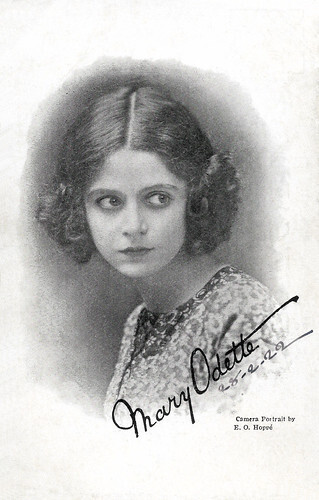
British postcard. Photo: E.O. Hoppé. Sent by mail in 1922.
Mary Odette (1901-1987) was a French actress who starred in British, Dutch, German, and French silent films.
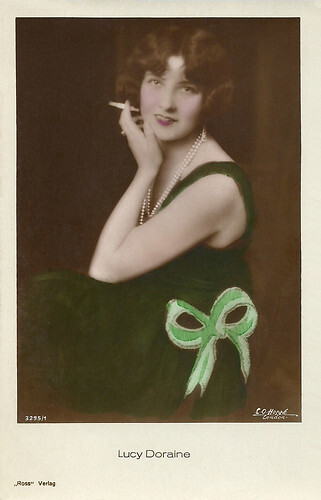
German postcard by Ross Verlag, Berlin, no. 3295/1, 1928-1929. Photo: E.O. Hoppé, London. Collection: Didier Hanson.
Despite her French name, Lucy Doraine (1898-1989) was a major Hungarian actress in the Austrian and German cinema of the 1920s. When she moved to Hollywood, the revolution of the sound film finished her career.
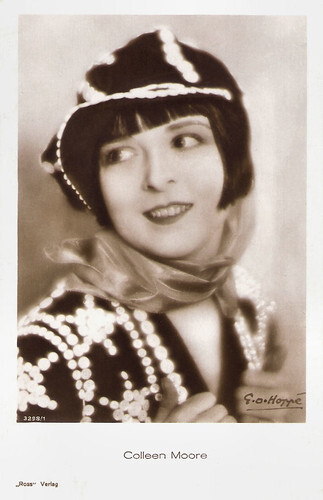
German postcard by Ross Verlag, no. 3298/1, 1928-1929. Photo: E.O. Hoppé.
American actress Colleen Moore (1899-1988) was a star of the silent screen who appeared in about 100 films beginning in 1917. During the 1920s, she put her stamp on American social history, creating in dozens of films the image of the wide-eyed, insouciant flapper with her bobbed hair and short skirts.
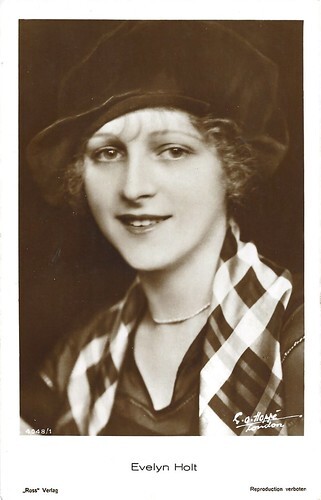
German postcard by Ross Verlag, Berlin, no. 4048/1, 1929-1930. Photo: E.O. Hoppé, London.
Evelyn Holt (1908-2001) was a highly popular German film actress in the late silent and early sound era.
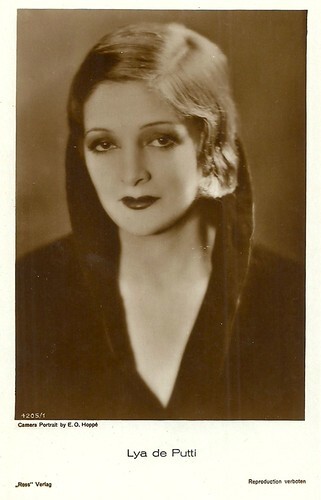
German postcard by Ross Verlag, no. 4205/1, 1929-1930. Photo: E.O. Hoppé.
Lya de Putti (1899-1931) portrayed vamps in German and American silent films.
Increasingly enamoured with photography
Emil Otto Hoppé (1878-1972) was born to a wealthy family in Munich. He was the only son of a prominent banker and was educated in schools in Munich, Paris and Vienna. Upon leaving school he served apprenticeships in German banks. In 1900, he accepted a position with the Shanghai Banking Corporation. He never arrived in China. The first leg of his journey took him to England where he met an old school friend and Hoppé decided to stay in London. While working for the Deutsche Bank, he became increasingly enamoured with photography and in 1903, he joined the Royal Photographic Society. In 1905, Hoppé married his old school friend's sister, Marion Bliersbach, and in 1907, he jettisoned his commercial career and opened a portrait studio.
From 1907 to 1911 he worked in London together with E. F. Griffin as a portrait photographer. Within a few years, E.O. Hoppé was one of the leaders of pictorial portraiture in Europe. He organised numerous exhibitions. His reputation attracted many important British and North American figures in politics, literature, and the arts. In 1909, he represented Great Britain at the International Photography Exhibition in Dresden. The following year, 70 portrait photographs by Hoppé were shown at an exhibition of the Royal Photographic Society. This was the first exhibition the Society dedicated to a single photographer. In the era before the First World War, Hoppé photographed such celebrities as Henry James, Rudyard Kipling, John Masefield, Léon Bakst, Anna Pavlova , Vaslav Nijinsky and other dancers of the Ballets Russes, and Richard Strauss. By 1919, Hoppé also had begun to travel the world in search of new subjects and landscapes. His journeys brought him to Africa, Germany, Poland, Romania, Czechoslovakia, the United States, Cuba, Jamaica and the West Indies, Australia, New Zealand, Japan, Indonesia, Singapore, Malaya, India and Ceylon. The resulting photographs were published in a number of books.
In 1921 he photographed portraits of King George V and Queen Mary at Buckingham Palace, which were distributed worldwide as postcards and posters. His other subjects of the 1920s included Albert Einstein, Benito Mussolini, Aldous Huxley, George Bernard Shaw and A.A. Milne. In 1928 Hoppé travelled to Germany and did many portrait sittings in Berlin. He also made photographs for the Ufa film studio. His photographs were presented in two books that were published in Germany in the next few years. In the 1930s Hoppé photographed a number of dancers at the Vic-Wells company including Margot Fonteyn and Ninette de Valois. Hoppé also made portraits of the street types of London: he photographed English cleaners, maids, and street vendors both in his studio and on the street. He continued this practice of capturing ordinary working men and women throughout his career as he travelled throughout the world.
In 1954, at the age of 76, Emil Otto Hoppé sold his body of photographic work to a commercial London picture archive, the Mansell Collection. In the collection, the work was filed by the subject with millions of other stock pictures and was no longer accessible by the author. Almost all of Hoppé's photographic work was accidentally obscured from photo-historians and from photo-history itself. Hoppé died in London in 1972 at the age of 94.
Hoppé's photos remained in the Mansell collection for decades after his death, until the collection closed down and was acquired by new owners in the United States. In 1994 photographic art curator Graham Howe retrieved Hoppé's photographic work from the picture library and rejoined it with the Hoppé family archive of photographs and biographical documents. This was the first time since 1954 that the complete E.O. Hoppé Collection was gathered together. Many years were spent in cataloguing, conservation, and research of the recovered work. Hoppé published a number of books including 'The Book of Fair Women' (1922), 'Taken from Life' (1922) and 'London Types' (1926) and his autobiography 'Hundred Thousands Exposures' (1945).
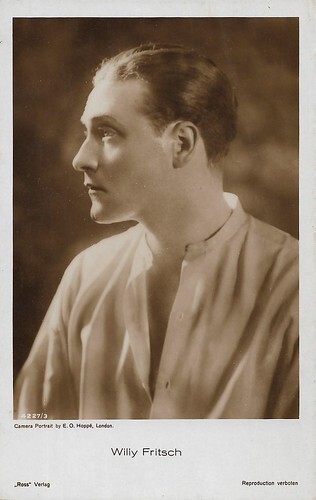
German postcard by Ross Verlag, no. 4227/3, 1929-1930. Photo: E.O. Hoppé, London.
Willy Fritsch (1901-1973) was the immensely popular ‘Sunny Boy’ of the Ufa operettas of the 1930s and 1940s.
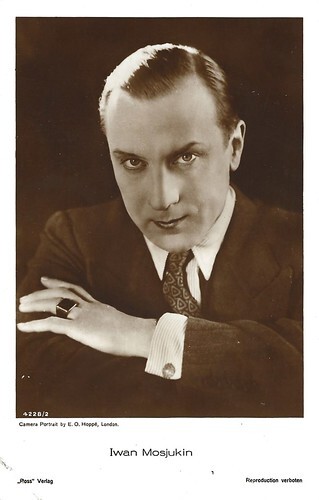
German postcard by Ross Verlag, no. 4228/1, 1929-1930. Photo: E.O. Hoppé, London.
Russian actor Ivan Mozzhukhin (in French Ivan Mosjoukine and in German Iwan Mosjukin) (1889-1939) was a legendary star of the European silent film, who shone in Russia, France, Germany and Austria, but suffered in Hollywood.
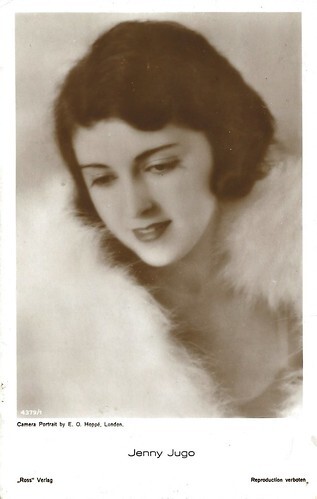
German postcard by Ross Verlag, Berlin, no. 4372/1, 1929-1930. Photo: E.O. Hoppé, London.
Pretty Austrian actress Jenny Jugo (1904-2001) appeared in more than fifty films between 1925 and 1950. Towards the end of the silent era, she fared well in comedies and this trend continued into the 1930s. She starred between 1931 and 1942 in eleven smart and charming comedies directed by Erich Engel.
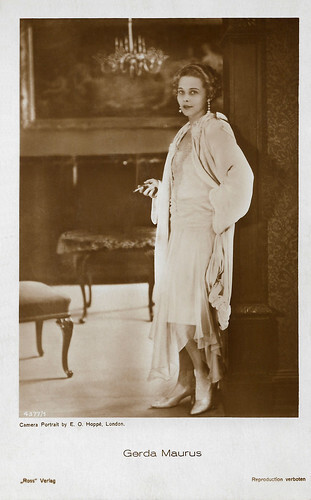
German postcard by Ross Verlag, Berlin, no. 4377/1, 1929-1930 Photo: E.O. Hoppé, London.
Austrian actress Gerda Maurus (1903-1968) was a star of the silent screen. With her protruded cheekbones and her forceful look, she bewitched many men, including her director Fritz Lang and Nazi Minister Josef Goebbels.
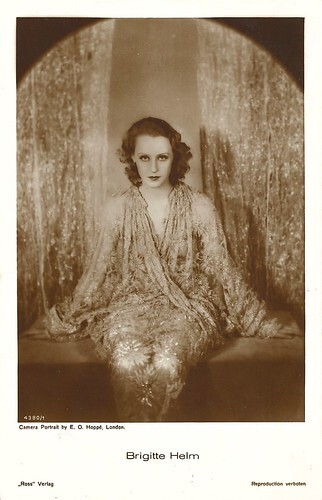
German postcard by Ross Verlag, Berlin, no. 4380/1, 1929-1930. Photo: E.O. Hoppé, London.
German actress Brigitte Helm (1908-1996) is still famous for her dual role as Maria and her double the evil Maria, the Maschinenmensch, in the silent SF classic Metropolis (Fritz Lang, 1927). After Metropolis she made a string of over 30 films in which she almost always had the starring role. She easily made the transition to sound films, before she abruptly retired in 1935.
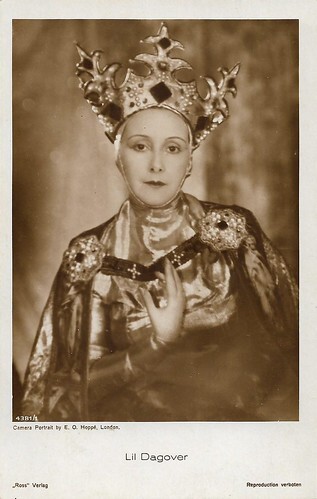
German postcard by Ross Verlag, no. 4381/1, 1929-1930. Photo: E.O. Hoppé, London.
German, but Dutch-born film actress Lil Dagover (1887-1980) was an exotic, dark beauty, who featured prominently during the golden age of the German silent cinema. She had her breakthrough as the prey of Dr. Caligari's monster in the classic expressionist film Das Cabinet des Dr. Caligari (1920) but gradually her fine and evanescent beauty changed and she turned into a 'Salondame', a lady of the screen. Her career would span nearly six decades.
Sources: National Portrait Gallery, E.O. Hoppé.com, Wikipedia (English and German).

British postcard. Photo: E.O. Hoppé. Sent by mail in 1922.
Mary Odette (1901-1987) was a French actress who starred in British, Dutch, German, and French silent films.

German postcard by Ross Verlag, Berlin, no. 3295/1, 1928-1929. Photo: E.O. Hoppé, London. Collection: Didier Hanson.
Despite her French name, Lucy Doraine (1898-1989) was a major Hungarian actress in the Austrian and German cinema of the 1920s. When she moved to Hollywood, the revolution of the sound film finished her career.

German postcard by Ross Verlag, no. 3298/1, 1928-1929. Photo: E.O. Hoppé.
American actress Colleen Moore (1899-1988) was a star of the silent screen who appeared in about 100 films beginning in 1917. During the 1920s, she put her stamp on American social history, creating in dozens of films the image of the wide-eyed, insouciant flapper with her bobbed hair and short skirts.

German postcard by Ross Verlag, Berlin, no. 4048/1, 1929-1930. Photo: E.O. Hoppé, London.
Evelyn Holt (1908-2001) was a highly popular German film actress in the late silent and early sound era.

German postcard by Ross Verlag, no. 4205/1, 1929-1930. Photo: E.O. Hoppé.
Lya de Putti (1899-1931) portrayed vamps in German and American silent films.
Increasingly enamoured with photography
Emil Otto Hoppé (1878-1972) was born to a wealthy family in Munich. He was the only son of a prominent banker and was educated in schools in Munich, Paris and Vienna. Upon leaving school he served apprenticeships in German banks. In 1900, he accepted a position with the Shanghai Banking Corporation. He never arrived in China. The first leg of his journey took him to England where he met an old school friend and Hoppé decided to stay in London. While working for the Deutsche Bank, he became increasingly enamoured with photography and in 1903, he joined the Royal Photographic Society. In 1905, Hoppé married his old school friend's sister, Marion Bliersbach, and in 1907, he jettisoned his commercial career and opened a portrait studio.
From 1907 to 1911 he worked in London together with E. F. Griffin as a portrait photographer. Within a few years, E.O. Hoppé was one of the leaders of pictorial portraiture in Europe. He organised numerous exhibitions. His reputation attracted many important British and North American figures in politics, literature, and the arts. In 1909, he represented Great Britain at the International Photography Exhibition in Dresden. The following year, 70 portrait photographs by Hoppé were shown at an exhibition of the Royal Photographic Society. This was the first exhibition the Society dedicated to a single photographer. In the era before the First World War, Hoppé photographed such celebrities as Henry James, Rudyard Kipling, John Masefield, Léon Bakst, Anna Pavlova , Vaslav Nijinsky and other dancers of the Ballets Russes, and Richard Strauss. By 1919, Hoppé also had begun to travel the world in search of new subjects and landscapes. His journeys brought him to Africa, Germany, Poland, Romania, Czechoslovakia, the United States, Cuba, Jamaica and the West Indies, Australia, New Zealand, Japan, Indonesia, Singapore, Malaya, India and Ceylon. The resulting photographs were published in a number of books.
In 1921 he photographed portraits of King George V and Queen Mary at Buckingham Palace, which were distributed worldwide as postcards and posters. His other subjects of the 1920s included Albert Einstein, Benito Mussolini, Aldous Huxley, George Bernard Shaw and A.A. Milne. In 1928 Hoppé travelled to Germany and did many portrait sittings in Berlin. He also made photographs for the Ufa film studio. His photographs were presented in two books that were published in Germany in the next few years. In the 1930s Hoppé photographed a number of dancers at the Vic-Wells company including Margot Fonteyn and Ninette de Valois. Hoppé also made portraits of the street types of London: he photographed English cleaners, maids, and street vendors both in his studio and on the street. He continued this practice of capturing ordinary working men and women throughout his career as he travelled throughout the world.
In 1954, at the age of 76, Emil Otto Hoppé sold his body of photographic work to a commercial London picture archive, the Mansell Collection. In the collection, the work was filed by the subject with millions of other stock pictures and was no longer accessible by the author. Almost all of Hoppé's photographic work was accidentally obscured from photo-historians and from photo-history itself. Hoppé died in London in 1972 at the age of 94.
Hoppé's photos remained in the Mansell collection for decades after his death, until the collection closed down and was acquired by new owners in the United States. In 1994 photographic art curator Graham Howe retrieved Hoppé's photographic work from the picture library and rejoined it with the Hoppé family archive of photographs and biographical documents. This was the first time since 1954 that the complete E.O. Hoppé Collection was gathered together. Many years were spent in cataloguing, conservation, and research of the recovered work. Hoppé published a number of books including 'The Book of Fair Women' (1922), 'Taken from Life' (1922) and 'London Types' (1926) and his autobiography 'Hundred Thousands Exposures' (1945).

German postcard by Ross Verlag, no. 4227/3, 1929-1930. Photo: E.O. Hoppé, London.
Willy Fritsch (1901-1973) was the immensely popular ‘Sunny Boy’ of the Ufa operettas of the 1930s and 1940s.

German postcard by Ross Verlag, no. 4228/1, 1929-1930. Photo: E.O. Hoppé, London.
Russian actor Ivan Mozzhukhin (in French Ivan Mosjoukine and in German Iwan Mosjukin) (1889-1939) was a legendary star of the European silent film, who shone in Russia, France, Germany and Austria, but suffered in Hollywood.

German postcard by Ross Verlag, Berlin, no. 4372/1, 1929-1930. Photo: E.O. Hoppé, London.
Pretty Austrian actress Jenny Jugo (1904-2001) appeared in more than fifty films between 1925 and 1950. Towards the end of the silent era, she fared well in comedies and this trend continued into the 1930s. She starred between 1931 and 1942 in eleven smart and charming comedies directed by Erich Engel.

German postcard by Ross Verlag, Berlin, no. 4377/1, 1929-1930 Photo: E.O. Hoppé, London.
Austrian actress Gerda Maurus (1903-1968) was a star of the silent screen. With her protruded cheekbones and her forceful look, she bewitched many men, including her director Fritz Lang and Nazi Minister Josef Goebbels.

German postcard by Ross Verlag, Berlin, no. 4380/1, 1929-1930. Photo: E.O. Hoppé, London.
German actress Brigitte Helm (1908-1996) is still famous for her dual role as Maria and her double the evil Maria, the Maschinenmensch, in the silent SF classic Metropolis (Fritz Lang, 1927). After Metropolis she made a string of over 30 films in which she almost always had the starring role. She easily made the transition to sound films, before she abruptly retired in 1935.

German postcard by Ross Verlag, no. 4381/1, 1929-1930. Photo: E.O. Hoppé, London.
German, but Dutch-born film actress Lil Dagover (1887-1980) was an exotic, dark beauty, who featured prominently during the golden age of the German silent cinema. She had her breakthrough as the prey of Dr. Caligari's monster in the classic expressionist film Das Cabinet des Dr. Caligari (1920) but gradually her fine and evanescent beauty changed and she turned into a 'Salondame', a lady of the screen. Her career would span nearly six decades.
Sources: National Portrait Gallery, E.O. Hoppé.com, Wikipedia (English and German).
Published on December 08, 2023 22:00
December 7, 2023
Warren Beatty
Warren Beatty (1937) is an American film actor, director, producer and the younger brother of Shirley MacLaine. Immediately after his debut in Splendor in the Grass (1961), he was Hollywood's most promising 'Jeune premier'. He had his breakthrough with Bonnie and Clyde (1967) opposite Faye Dunaway. Later, he made such hit films as Shampoo (1975) and Heaven Can Wait (1978), but his most lauded film is Reds (1981). Beatty is the only person to be nominated for four Oscars (Best Picture, Directing, Lead Actor & Screenplay) in the same year in two times. First for Heaven Can Wait (1978), and later for Reds (1981).
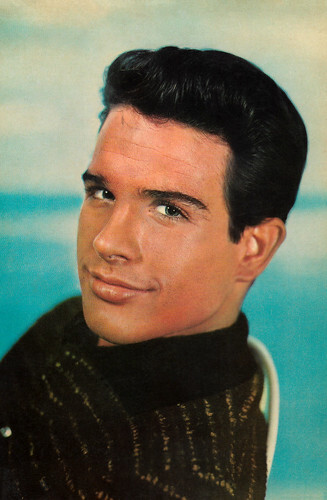
Spanish postcard by Raker, no. 1105.
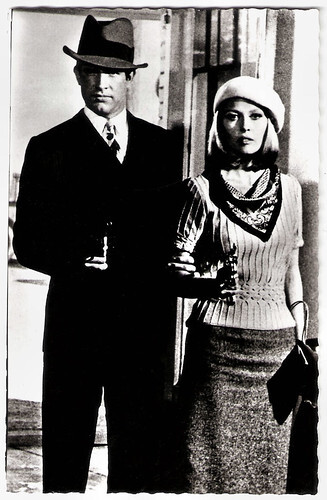
Dutch postcard. Photo: Warren Beatty and Faye Dunaway in Bonnie and Clyde (Arthur Penn, 1967).
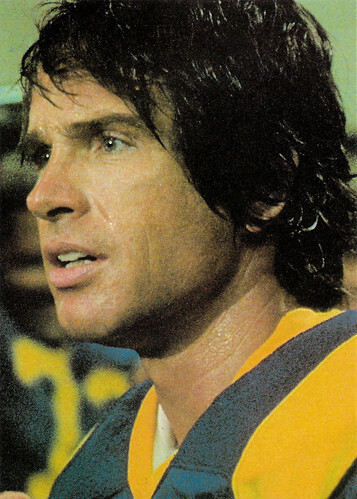
British postcard by Star-Graphics, London, no. S 94. Warren Beatty in Heaven Can Wait (Warren Beatty, Buck Henry, 1978).
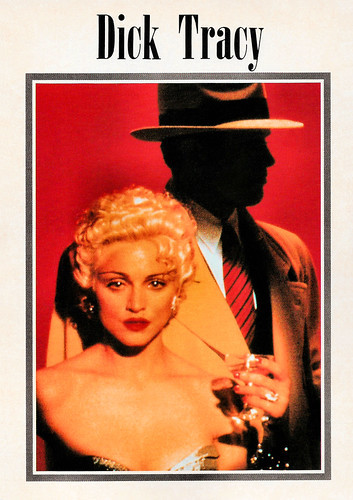
British postcard New-Line, no. 229. Photo: Madonna and Warren Beatty in Dick Tracy (Warren Beatty, 1990).
A tortured teenager in love
Warren Beatty was born Henry Warren Beaty in 1937, in Richmond, Virginia, U.S. His mother, Kathlyn Corinne (née MacLean), was a teacher from Nova Scotia. His father, Ira Owens Beaty, studied for a PhD in educational psychology and was a teacher and school administrator, in addition to working in real estate. His older sister is actress Shirley MacLaine .
Beatty played football in high school but was more interested in theatre, encouraged to act by the success of his sister, who established herself as a Hollywood star. He attended Northwestern University in Evanston, Illinois, for one year before moving to New York City, where he studied with acting coach Stella Adler.
He occasionally appeared onstage and from 1957 on television as well. In 1959 he earned a recurring role in the television series The Many Loves of Dobie Gillis but left the show before the first season ended to make his only Broadway appearance, in William Inge's 'A Loss of Roses' (1959). Beatty received a Tony Award nomination for his Broadway debut.
He then made a strong screen debut as a tortured teenager in love in Splendor in the Grass (Elia Kazan, 1961) opposite Natalie Wood . The film was a major critical and box office success and Beatty was nominated for a Golden Globe Award for Best Actor and received the award for New Star of the Year – Actor. The film was also nominated for two Oscars, winning one.
His next films were Tennessee Williams' The Roman Spring of Mrs. Stone (Jose Quintero, 1961), with Vivien Leigh and Lotte Lenya, All Fall Down (John Frankenheimer, 1962), with Angela Lansbury , Lilith (Robert Rossen, 1963), with Jean Seberg and Promise Her Anything (Arthur Hiller, 1964), with Leslie Caron . Although interesting efforts, these films were mostly financial disappointments.
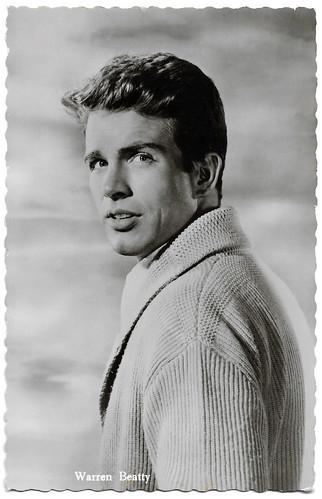
Dutch postcard, no. 662. Collection: Geoffrey Donaldson Institute.
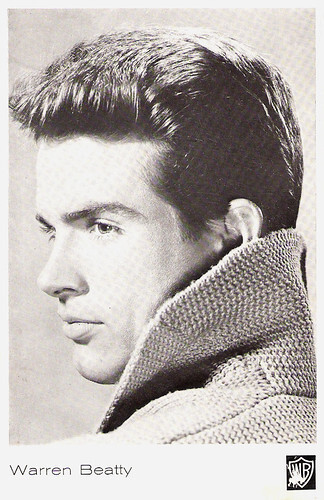
Belgian promotion card by Vita to promote Splendor in the Grass (Elia Kazan, 1961). Photo: Warner Bros.
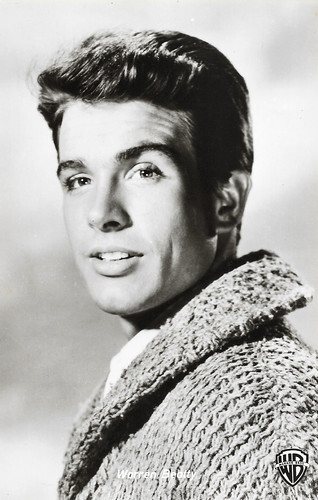
West German postcard by Kolibri / Friedrich W. Sander Verlag, Minden/Westf., no. 2769. Photo: Warner Bros. Warren Beatty in Splendor in the Grass (Elia Kazan, 1961).
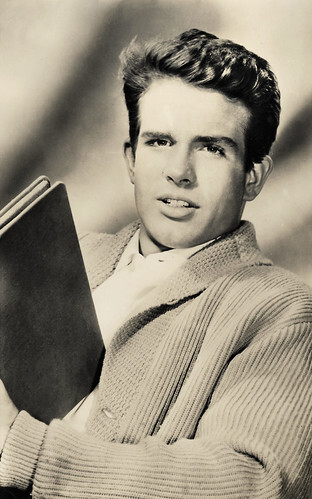
Spanish postcard by Ediciones Raker, Barcelona, no. 323, 1963. Photo: Mundial Film. Warren Beatty in Splendor in the Grass (Elia Kazan, 1961).
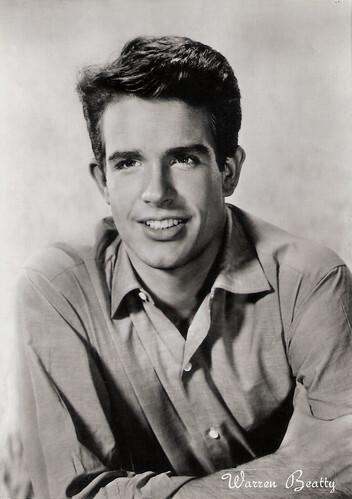
Italian postcard by Rotalfoto, Milano, no. 1151.
A colossal hit and a milestone in cinema history
Taking command of his career, Warren Beatty formed a production company, Tatira, in 1965. Beatty assigned himself the duties of star and producer for Bonnie and Clyde (Arthur Penn, 1967), the story of Great Depression-era bank robbers Bonnie Parker ( Faye Dunaway ) and Clyde Barrow.
When he made his deal with Warner Bros. for Bonnie and Clyde, the studio had such little faith in the future box-office results from the $2.5-million production that it agreed to give the film's star and first-time producer 40% of the box-office gross. The deal worked out quite well for Beatty. Counterculture audiences of the 1960s identified with the film’s outlaw heroes, thanks largely to Beatty’s performance, which was filled with much compassion for Barrow and the poor in America.
Beatty had worked before with Penn on Mickey One (Arthur Penn, 1965). Bonnie and Clyde received much attention for the artfully rendered climactic shoot-out, which set new standards for screen violence. It became a colossal hit and a milestone in cinema history. It was nominated for 10 Academy Awards, including Best Picture and Best Actor (Beatty). Between 1967 and 1973 when the film played in theatres, it generated over $70 million worldwide at the box office, netting Beatty an estimated $28 million.
Never one to rush into projects, Beatty acted in only four films in the next seven years. From 1967 to 1974, he lived off-and-on with British actress Julie Christie . He co-starred with her in Robert Altman’s revisionist Western McCabe & Mrs. Miller (1971). He also played the lead in Alan J. Pakula’s paranoid thriller The Parallax View (1974).
His next big hit was Shampoo (Hal Ashby, 1975) with Julie Christie , Goldie Hawn and Lee Grant. Britannica describes the film as "a comic sex romp, flavoured with a left-wing sensibility". Beatty plays a womanising hairdresser who finds it impossible to juggle all his lovers on the eve of Pres. Richard Nixon’s election in 1968. Beatty starred in the film, produced, and wrote it with Robert Towne. Shampoo was nominated for four Academy Awards. Even more successful was Heaven Can Wait (Warren Beatty, Buck Henry, 1978) again with Julie Christie . It was a showcase vehicle for Beatty’s comedic talents. Beatty was nominated for Academy Awards in four separate categories (Best Actor, Best Picture [as producer], Adapted Screenplay, and Best Direction), an unprecedented achievement in Hollywood history and an achievement he was to repeat with his next film.
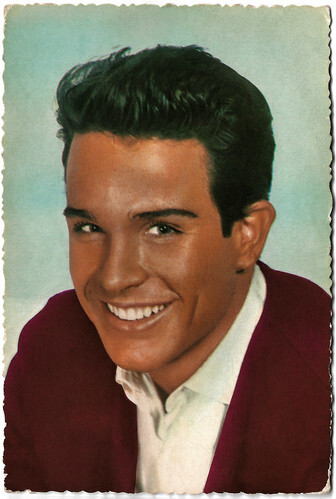
Spanish postcard by Archivo Bermejo, no. C-70. Photo: Warner Bros. Warren Beatty in Splendor in the Grass (Elia Kazan, 1961).
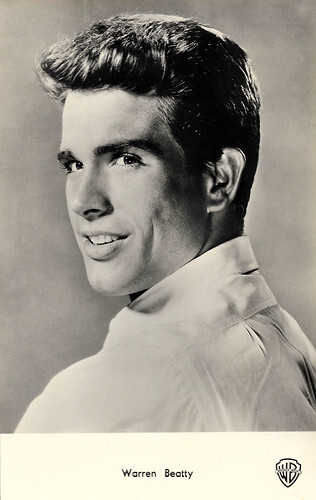
French postcard by Editions P.I., Paris, no. 1157, no. 1105. Photo: Warner Bros. Warren Beatty in The Roman Spring of Mrs. Stone (Jose Quintero, 1961).
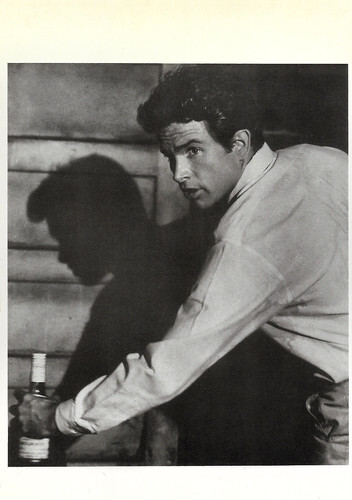
Canadian postcard by Canadian Postcard, no. A-216. Warren Beatty in All Fall Down (John Frankenheimer, 1962).
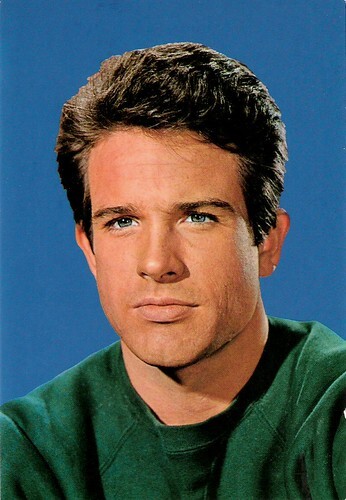
American postcard by Quantity Postcards, San Francisco, CA., nr. SC. 11.
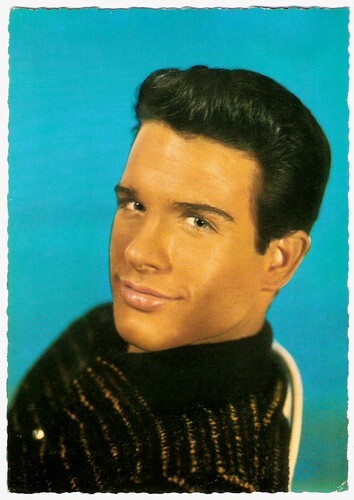
French postcard by E.D.U.G., no. 260.
A star-studded adaptation of a comic strip
Reds (Warren Beatty, 1981) was the film that established Warren Beatty as a serious filmmaker. The historical epic about American Communist journalist John Reed who observed the Russian October Revolution of 1917 received Oscar nominations in all the major categories and won Beatty an Oscar for Best Director. He did not direct again for nine years when he chose as his next vehicle a star-studded adaptation of a comic strip.
Dick Tracy (Warren Beatty, 1990), co-starring Al Pacino and Madonna , received positive reviews and was one of the highest-grossing films of the year. His notable films of the 1990s include Bugsy (Barry Levinson, 1991), about the infamous gangster, and Love Affair (Glenn Gordon Caron, 1994), both costarring Annette Bening, whom Beatty married in 1992.
In 1998 he co-wrote, directed, and starred in Bulworth, playing a U.S. senator whose disillusionment with the political system is fueled by his immersion in hip-hop culture. Despite the accolades he received, Beatty was also part of two of Hollywood’s most expensive failures, Ishtar (Elaine May, 1987) and Town & Country (Peter Chelsom, 2001).
After a 15-year absence, he returned to the big screen with Rules Don’t Apply (Warren Beatty, 2016), about the relationship between an aspiring actress and her driver, both of whom work for Howard Hughes. In addition to starring as the eccentric millionaire, Beatty also wrote and directed the romance.
The Academy of Motion Picture Arts and Sciences granted Beatty the Irving G. Thalberg Memorial Award for his body of work in 2000, and he was a 2004 Kennedy Center Honor recipient. In 2008 Beatty received a lifetime achievement award from the American Film Institute. Warren Beatty and Annette Bening have four children: Kathlyn (b. 1992), Benjamin (1994), Isabel (1997) and Ella (2000). Daughter Kathlyn transitioned to male at the age of 14 and changed her name to Stephen Ira Beatty.
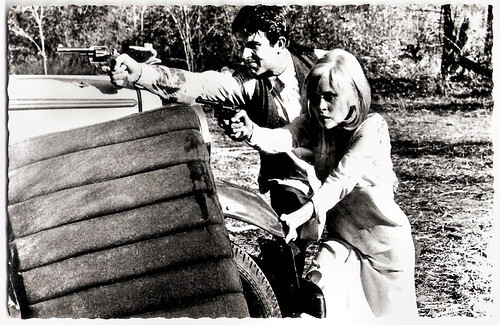
Dutch postcard. Photo: Faye Dunaway and Warren Beatty in Bonnie and Clyde (Arthur Penn, 1967).

Canadian postcard by Canadian Postcard, no. A-18. Photo: Columbia TriStar. Gene Hackman, Estelle Parsons, Warren Beatty, Faye Dunaway and Michael J. Pollard in Bonnie and Clyde (Arthur Penn, 1967).
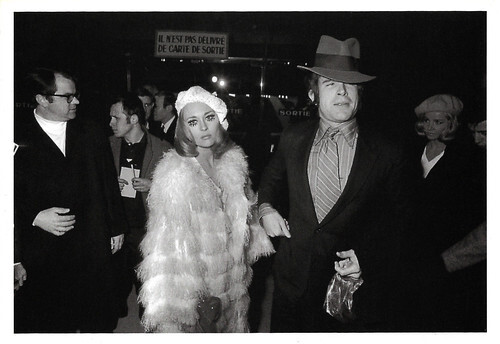
French postcard by Editions Hazan, 1996. Photo: Raymond Depardon. Faye Dunaway and Warren Beatty at the premiere of Bonnie and Clyde (Arthur Penn, 1967).
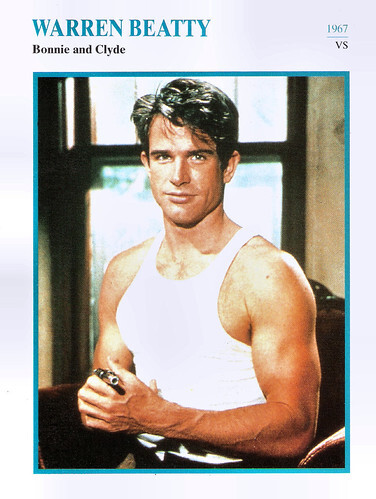
Dutch collectors card by Edito Service S.A. in the 'Filmsterren: een Portret' series, 1993, no. D5 024 62 09. Photo: A. Pelé / Stills. Warren Beatty in Bonnie and Clyde (Arthur Penn, 1967).
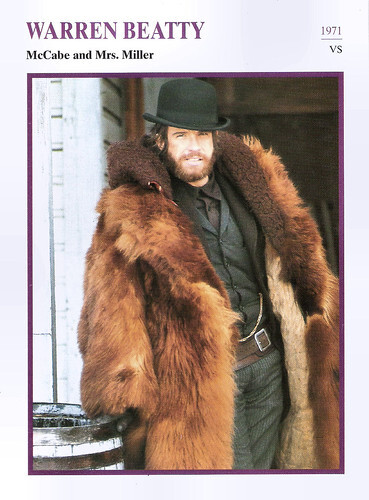
Dutch collectors card by Edito Service S.A. in the 'Filmsterren: een Portret' series, 1993, no. D5 024 62 09. Photo: The Kobal Collection. Warren Beatty in McCabe and Mrs. Miller (Robert Altman, 1971).
Sources: Britannica, Wikipedia (Dutch and English) and .

Spanish postcard by Raker, no. 1105.

Dutch postcard. Photo: Warren Beatty and Faye Dunaway in Bonnie and Clyde (Arthur Penn, 1967).

British postcard by Star-Graphics, London, no. S 94. Warren Beatty in Heaven Can Wait (Warren Beatty, Buck Henry, 1978).

British postcard New-Line, no. 229. Photo: Madonna and Warren Beatty in Dick Tracy (Warren Beatty, 1990).
A tortured teenager in love
Warren Beatty was born Henry Warren Beaty in 1937, in Richmond, Virginia, U.S. His mother, Kathlyn Corinne (née MacLean), was a teacher from Nova Scotia. His father, Ira Owens Beaty, studied for a PhD in educational psychology and was a teacher and school administrator, in addition to working in real estate. His older sister is actress Shirley MacLaine .
Beatty played football in high school but was more interested in theatre, encouraged to act by the success of his sister, who established herself as a Hollywood star. He attended Northwestern University in Evanston, Illinois, for one year before moving to New York City, where he studied with acting coach Stella Adler.
He occasionally appeared onstage and from 1957 on television as well. In 1959 he earned a recurring role in the television series The Many Loves of Dobie Gillis but left the show before the first season ended to make his only Broadway appearance, in William Inge's 'A Loss of Roses' (1959). Beatty received a Tony Award nomination for his Broadway debut.
He then made a strong screen debut as a tortured teenager in love in Splendor in the Grass (Elia Kazan, 1961) opposite Natalie Wood . The film was a major critical and box office success and Beatty was nominated for a Golden Globe Award for Best Actor and received the award for New Star of the Year – Actor. The film was also nominated for two Oscars, winning one.
His next films were Tennessee Williams' The Roman Spring of Mrs. Stone (Jose Quintero, 1961), with Vivien Leigh and Lotte Lenya, All Fall Down (John Frankenheimer, 1962), with Angela Lansbury , Lilith (Robert Rossen, 1963), with Jean Seberg and Promise Her Anything (Arthur Hiller, 1964), with Leslie Caron . Although interesting efforts, these films were mostly financial disappointments.

Dutch postcard, no. 662. Collection: Geoffrey Donaldson Institute.

Belgian promotion card by Vita to promote Splendor in the Grass (Elia Kazan, 1961). Photo: Warner Bros.

West German postcard by Kolibri / Friedrich W. Sander Verlag, Minden/Westf., no. 2769. Photo: Warner Bros. Warren Beatty in Splendor in the Grass (Elia Kazan, 1961).

Spanish postcard by Ediciones Raker, Barcelona, no. 323, 1963. Photo: Mundial Film. Warren Beatty in Splendor in the Grass (Elia Kazan, 1961).

Italian postcard by Rotalfoto, Milano, no. 1151.
A colossal hit and a milestone in cinema history
Taking command of his career, Warren Beatty formed a production company, Tatira, in 1965. Beatty assigned himself the duties of star and producer for Bonnie and Clyde (Arthur Penn, 1967), the story of Great Depression-era bank robbers Bonnie Parker ( Faye Dunaway ) and Clyde Barrow.
When he made his deal with Warner Bros. for Bonnie and Clyde, the studio had such little faith in the future box-office results from the $2.5-million production that it agreed to give the film's star and first-time producer 40% of the box-office gross. The deal worked out quite well for Beatty. Counterculture audiences of the 1960s identified with the film’s outlaw heroes, thanks largely to Beatty’s performance, which was filled with much compassion for Barrow and the poor in America.
Beatty had worked before with Penn on Mickey One (Arthur Penn, 1965). Bonnie and Clyde received much attention for the artfully rendered climactic shoot-out, which set new standards for screen violence. It became a colossal hit and a milestone in cinema history. It was nominated for 10 Academy Awards, including Best Picture and Best Actor (Beatty). Between 1967 and 1973 when the film played in theatres, it generated over $70 million worldwide at the box office, netting Beatty an estimated $28 million.
Never one to rush into projects, Beatty acted in only four films in the next seven years. From 1967 to 1974, he lived off-and-on with British actress Julie Christie . He co-starred with her in Robert Altman’s revisionist Western McCabe & Mrs. Miller (1971). He also played the lead in Alan J. Pakula’s paranoid thriller The Parallax View (1974).
His next big hit was Shampoo (Hal Ashby, 1975) with Julie Christie , Goldie Hawn and Lee Grant. Britannica describes the film as "a comic sex romp, flavoured with a left-wing sensibility". Beatty plays a womanising hairdresser who finds it impossible to juggle all his lovers on the eve of Pres. Richard Nixon’s election in 1968. Beatty starred in the film, produced, and wrote it with Robert Towne. Shampoo was nominated for four Academy Awards. Even more successful was Heaven Can Wait (Warren Beatty, Buck Henry, 1978) again with Julie Christie . It was a showcase vehicle for Beatty’s comedic talents. Beatty was nominated for Academy Awards in four separate categories (Best Actor, Best Picture [as producer], Adapted Screenplay, and Best Direction), an unprecedented achievement in Hollywood history and an achievement he was to repeat with his next film.

Spanish postcard by Archivo Bermejo, no. C-70. Photo: Warner Bros. Warren Beatty in Splendor in the Grass (Elia Kazan, 1961).

French postcard by Editions P.I., Paris, no. 1157, no. 1105. Photo: Warner Bros. Warren Beatty in The Roman Spring of Mrs. Stone (Jose Quintero, 1961).

Canadian postcard by Canadian Postcard, no. A-216. Warren Beatty in All Fall Down (John Frankenheimer, 1962).

American postcard by Quantity Postcards, San Francisco, CA., nr. SC. 11.

French postcard by E.D.U.G., no. 260.
A star-studded adaptation of a comic strip
Reds (Warren Beatty, 1981) was the film that established Warren Beatty as a serious filmmaker. The historical epic about American Communist journalist John Reed who observed the Russian October Revolution of 1917 received Oscar nominations in all the major categories and won Beatty an Oscar for Best Director. He did not direct again for nine years when he chose as his next vehicle a star-studded adaptation of a comic strip.
Dick Tracy (Warren Beatty, 1990), co-starring Al Pacino and Madonna , received positive reviews and was one of the highest-grossing films of the year. His notable films of the 1990s include Bugsy (Barry Levinson, 1991), about the infamous gangster, and Love Affair (Glenn Gordon Caron, 1994), both costarring Annette Bening, whom Beatty married in 1992.
In 1998 he co-wrote, directed, and starred in Bulworth, playing a U.S. senator whose disillusionment with the political system is fueled by his immersion in hip-hop culture. Despite the accolades he received, Beatty was also part of two of Hollywood’s most expensive failures, Ishtar (Elaine May, 1987) and Town & Country (Peter Chelsom, 2001).
After a 15-year absence, he returned to the big screen with Rules Don’t Apply (Warren Beatty, 2016), about the relationship between an aspiring actress and her driver, both of whom work for Howard Hughes. In addition to starring as the eccentric millionaire, Beatty also wrote and directed the romance.
The Academy of Motion Picture Arts and Sciences granted Beatty the Irving G. Thalberg Memorial Award for his body of work in 2000, and he was a 2004 Kennedy Center Honor recipient. In 2008 Beatty received a lifetime achievement award from the American Film Institute. Warren Beatty and Annette Bening have four children: Kathlyn (b. 1992), Benjamin (1994), Isabel (1997) and Ella (2000). Daughter Kathlyn transitioned to male at the age of 14 and changed her name to Stephen Ira Beatty.

Dutch postcard. Photo: Faye Dunaway and Warren Beatty in Bonnie and Clyde (Arthur Penn, 1967).

Canadian postcard by Canadian Postcard, no. A-18. Photo: Columbia TriStar. Gene Hackman, Estelle Parsons, Warren Beatty, Faye Dunaway and Michael J. Pollard in Bonnie and Clyde (Arthur Penn, 1967).

French postcard by Editions Hazan, 1996. Photo: Raymond Depardon. Faye Dunaway and Warren Beatty at the premiere of Bonnie and Clyde (Arthur Penn, 1967).

Dutch collectors card by Edito Service S.A. in the 'Filmsterren: een Portret' series, 1993, no. D5 024 62 09. Photo: A. Pelé / Stills. Warren Beatty in Bonnie and Clyde (Arthur Penn, 1967).

Dutch collectors card by Edito Service S.A. in the 'Filmsterren: een Portret' series, 1993, no. D5 024 62 09. Photo: The Kobal Collection. Warren Beatty in McCabe and Mrs. Miller (Robert Altman, 1971).
Sources: Britannica, Wikipedia (Dutch and English) and .
Published on December 07, 2023 22:00
December 6, 2023
Leslie Fenton
Leslie Fenton (1902–1978) was an English-born American actor and film director, who appeared in 62 films between 1923 and 1945. From 1939 he also directed some 19 films. Fenton was married to actress Ann Dvorak.
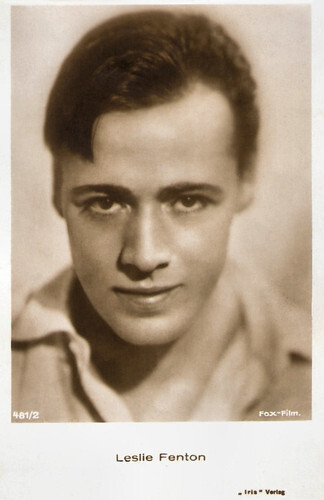
Austrian postcard by Iris Verlag, no. 481/2. Photo: Fox-Film.
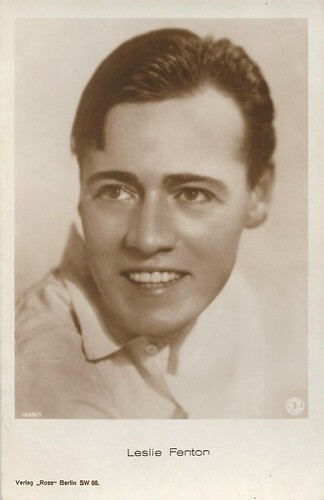
German postcard by Ross Verlag, Berlin, no. 1335/1, 1927-1928. Photo: Fox.
The Road to Glory
Leslie Fenton was born in 1902 in Liverpool, Lancashire. In 1909, Fenton emigrated to America with his mother, Elizabeth Carter Fenton, and his brothers, to join his father, shoe manufacturer's representative Richard Fenton, in Mifflin, Ohio.
After an initial job as an office clerk, Leslie Fenton moved to New York and became a theatre actor. He enjoyed his first successes in the role of the teenage hero.
In the mid-1920s, Fenton was signed to Hollywood and received a contract with Fox Studios, for which he appeared in the film East Lynne (Emmett J. Flynn, 1925) with Alma Rubens and Edmund Lowe.
In The Road to Glory (Howard Hawks, 1926), he had the male lead opposite May McAvoy . This was Hawks' first film. For Fox, Fenton also appeared in What Price Glory (Raoul Walsh, 1926), starring Victor McLaglen , Dolores del Rio and Edmund Lowe.
Leslie Fenton also played at Paramount, e.g. in the silent crime drama The Drag Net (Josef von Sternberg, 1928), starring George Bancroft .
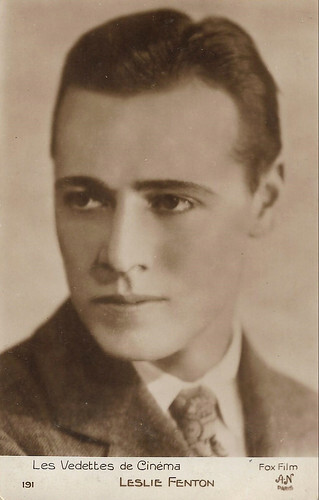
French postcard in the Les Vedettes de Cinéma series by A.N., Paris, no. 191. Photo: Fox Film.
The Streets of Laredo
Leslie Fenton appeared in a total of 62 feature films between 1923 and 1938, with Fenton usually given leading roles in B-movies and supporting roles in A productions. Probably his best-known performance today is as the dapper gangster boss Nails Nathan in the classic film The Public Enemy (William Wellman, 1931) with James Cagney , while he was also Cagney's antagonist in Lady Killer (Roy Del Ruth, 1933).
His career stagnated during the later 1930s. After a supporting role alongside Spencer Tracy as a murderer about to be executed in the opening scenes of Boys Town (Norman Taurog, 1938), he retired from acting.
Fenton went on to become a film director. By 1951 he had directed a total of 19 films. He made mainly B-movies in the Western and action genres, some of which film historians have subsequently regarded as well-directed entertainment films. Perhaps his best-known film today is the Western The Streets of Laredo (1949), starring William Holden . His career as a director ended as early as 1951 when he was not yet 50 years old.
In 1932 Fenton married actress Ann Dvorak, who followed him to England. There he stayed during the Second World War and achieved an officer's rank in the Royal Naval Reserve. He was seriously injured in Operation Chariot. Dvorak and Fenton divorced in 1945.
Leslie Fenton remarried in 1952 and the second marriage lasted until his death. Little is known about the last two and a half decades of Fenton's life. Leslie Fenton died in 1978 in Montecito, California, at the age of 76.
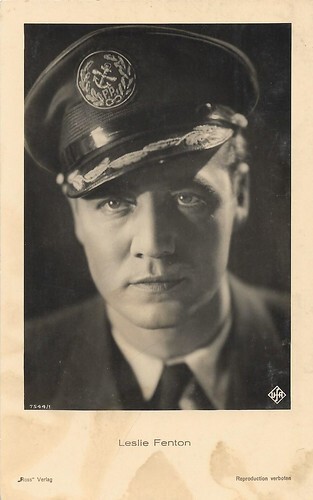
German postcard by Ross Verlag, Berlin, no. 7544/1, 1932-33. Ufa. Leslie Fenton as Capt. lt. Droste in the English language version of F.P.1 (Karl Hartl, 1933). The film was shot in 1932 at the Ufa studios in Berlin, as well as at the Hamburg Howaldt shipyard, in Cuxhaven and Warnemunde, as on platforms designed by Erik Kettelhut on the Baltic Sea island of Greifswalder Oie. While the German version already came out in 1932, the English version was released in 1933 in Britain by Gaumont-British and in the US by Fox.
Sources: Wikipedia (German and English) and .

Austrian postcard by Iris Verlag, no. 481/2. Photo: Fox-Film.

German postcard by Ross Verlag, Berlin, no. 1335/1, 1927-1928. Photo: Fox.
The Road to Glory
Leslie Fenton was born in 1902 in Liverpool, Lancashire. In 1909, Fenton emigrated to America with his mother, Elizabeth Carter Fenton, and his brothers, to join his father, shoe manufacturer's representative Richard Fenton, in Mifflin, Ohio.
After an initial job as an office clerk, Leslie Fenton moved to New York and became a theatre actor. He enjoyed his first successes in the role of the teenage hero.
In the mid-1920s, Fenton was signed to Hollywood and received a contract with Fox Studios, for which he appeared in the film East Lynne (Emmett J. Flynn, 1925) with Alma Rubens and Edmund Lowe.
In The Road to Glory (Howard Hawks, 1926), he had the male lead opposite May McAvoy . This was Hawks' first film. For Fox, Fenton also appeared in What Price Glory (Raoul Walsh, 1926), starring Victor McLaglen , Dolores del Rio and Edmund Lowe.
Leslie Fenton also played at Paramount, e.g. in the silent crime drama The Drag Net (Josef von Sternberg, 1928), starring George Bancroft .

French postcard in the Les Vedettes de Cinéma series by A.N., Paris, no. 191. Photo: Fox Film.
The Streets of Laredo
Leslie Fenton appeared in a total of 62 feature films between 1923 and 1938, with Fenton usually given leading roles in B-movies and supporting roles in A productions. Probably his best-known performance today is as the dapper gangster boss Nails Nathan in the classic film The Public Enemy (William Wellman, 1931) with James Cagney , while he was also Cagney's antagonist in Lady Killer (Roy Del Ruth, 1933).
His career stagnated during the later 1930s. After a supporting role alongside Spencer Tracy as a murderer about to be executed in the opening scenes of Boys Town (Norman Taurog, 1938), he retired from acting.
Fenton went on to become a film director. By 1951 he had directed a total of 19 films. He made mainly B-movies in the Western and action genres, some of which film historians have subsequently regarded as well-directed entertainment films. Perhaps his best-known film today is the Western The Streets of Laredo (1949), starring William Holden . His career as a director ended as early as 1951 when he was not yet 50 years old.
In 1932 Fenton married actress Ann Dvorak, who followed him to England. There he stayed during the Second World War and achieved an officer's rank in the Royal Naval Reserve. He was seriously injured in Operation Chariot. Dvorak and Fenton divorced in 1945.
Leslie Fenton remarried in 1952 and the second marriage lasted until his death. Little is known about the last two and a half decades of Fenton's life. Leslie Fenton died in 1978 in Montecito, California, at the age of 76.

German postcard by Ross Verlag, Berlin, no. 7544/1, 1932-33. Ufa. Leslie Fenton as Capt. lt. Droste in the English language version of F.P.1 (Karl Hartl, 1933). The film was shot in 1932 at the Ufa studios in Berlin, as well as at the Hamburg Howaldt shipyard, in Cuxhaven and Warnemunde, as on platforms designed by Erik Kettelhut on the Baltic Sea island of Greifswalder Oie. While the German version already came out in 1932, the English version was released in 1933 in Britain by Gaumont-British and in the US by Fox.
Sources: Wikipedia (German and English) and .
Published on December 06, 2023 22:00
Paul van Yperen's Blog
- Paul van Yperen's profile
- 13 followers
Paul van Yperen isn't a Goodreads Author
(yet),
but they
do have a blog,
so here are some recent posts imported from
their feed.



